With the visit to the Michamvi peninsula, which is located on the eastern side of Unguja, the largest island in the Zanzibar archipelago, the excursions offered to the group in which I travelled on this occasion practically ended. But that was not the end of the tours for me. Before I deal with the trip that I thought up for myself, let me also mention that no matter in which part of Unguja the visitor stays, numerous trips are offered everywhere and they are more or less similar, at least in terms of their basic concept. I really liked that the first couple of days we were based in Stone Town in the west of the island and the rest in the village of Nungwi in the far north, but as far as the trips themselves are concerned, it almost doesn’t matter where the visitor is stationed.
Almost every morning during my stay in Nungwi, I started my day with breakfast in the hotel restaurant from where I had a spectacular view. The appearance of the landscape in front of me depended only on the current situation with the clouds in the sky and possibly on the tides, but in every version it was exceptional!
 Nungwi Beach
Nungwi Beach
 Nungwi Beach
Nungwi Beach
And when I finished with the breakfast, I would take my coffee and just move to a table in another part of the restaurant to continue enjoying.
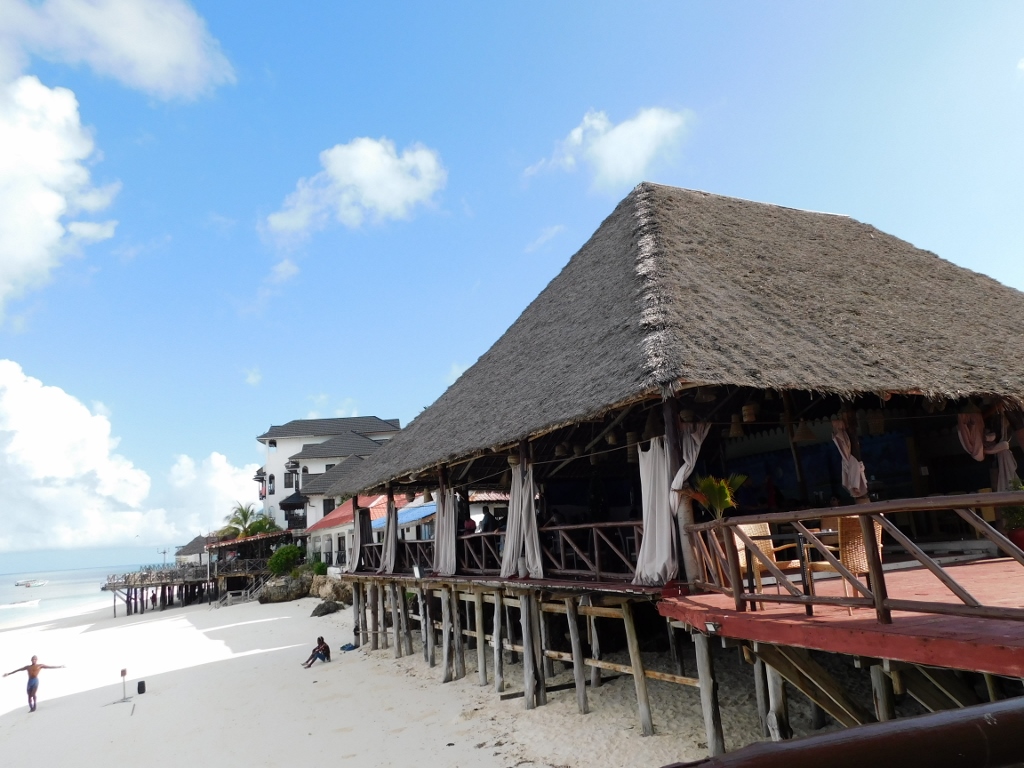 Restaurant for breakfast, as well as a superb viewpoint
Restaurant for breakfast, as well as a superb viewpoint
During my stay in Zanzibar, the low tide started just about the time when I was having breakfast. By the time I had my coffee, the water would have receded a lot and the local residents were now looking for something in the shallows. I’ve mentioned before that I assume they were looking for octopuses or some shellfish that were stuck there by the ebbing sea. At the same time, those who had no obligations simply strolled in the shallow waters.
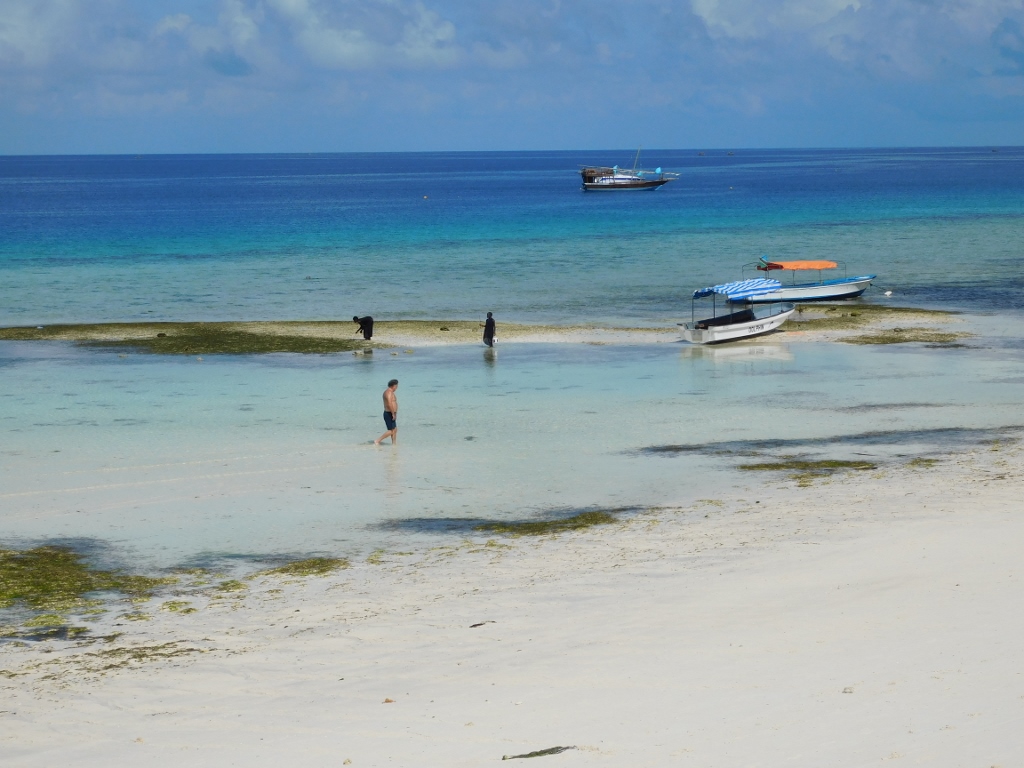 Nungwi Beach during low tide
Nungwi Beach during low tide
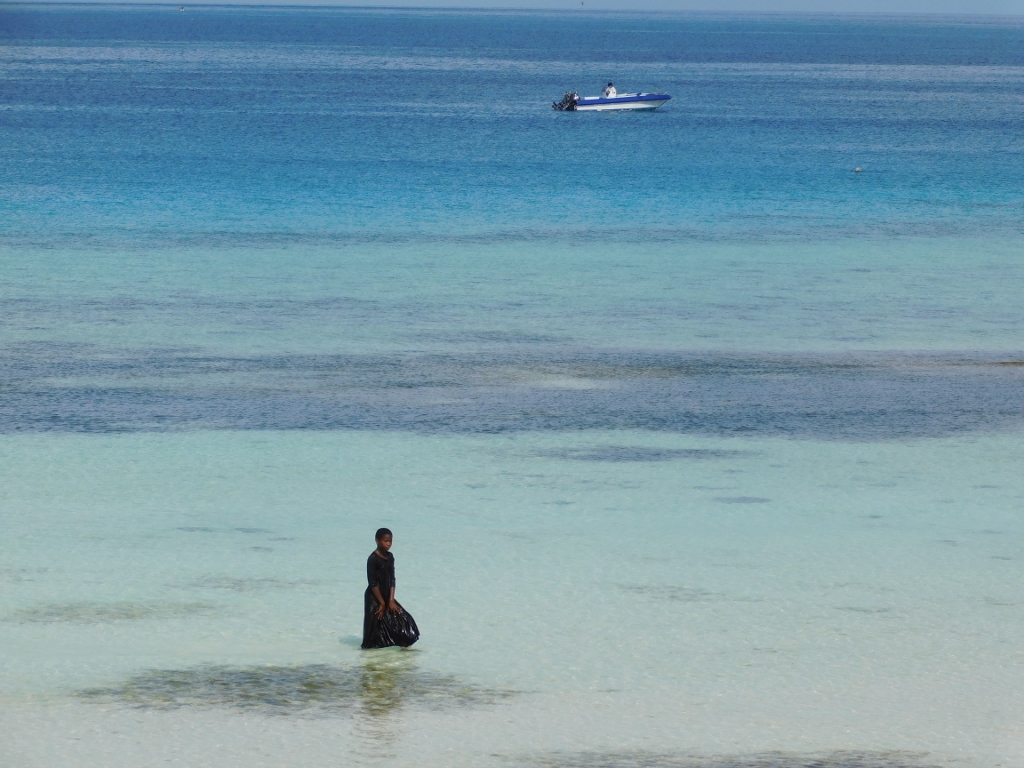 Nungwi Beach during low tide
Nungwi Beach during low tide
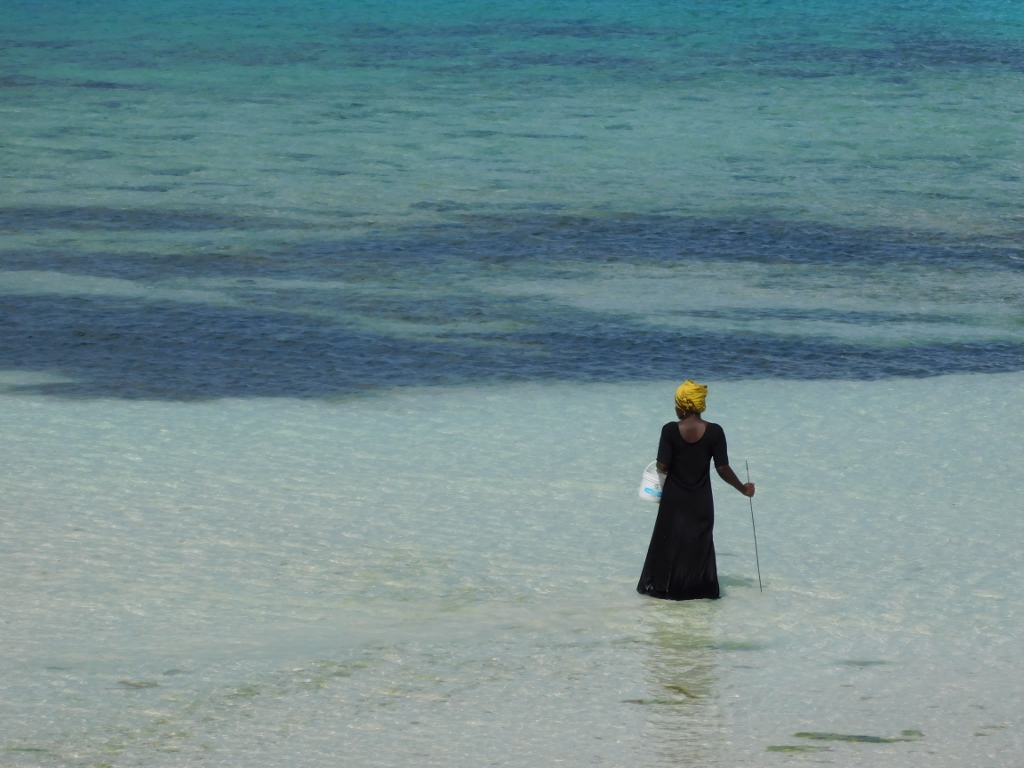 Nungwi Beach during low tide
Nungwi Beach during low tide
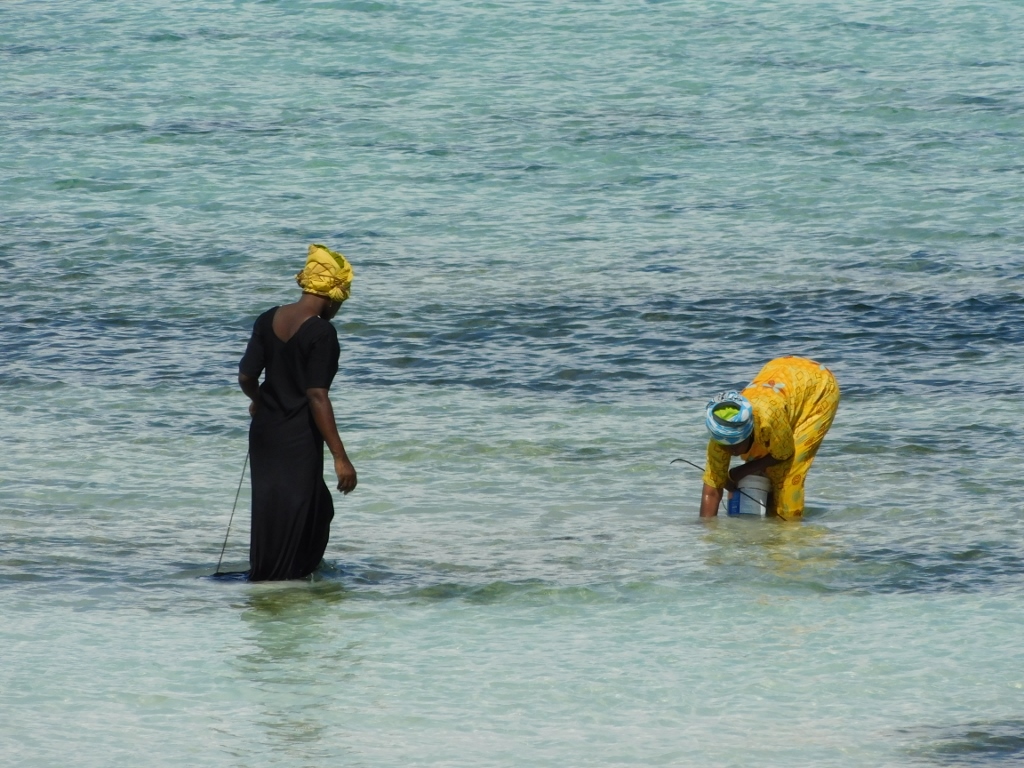 Nungwi Beach during low tide
Nungwi Beach during low tide
After this quiet and relaxed morning, I met the driver who was taking me on an excursion that day. Namely, I wanted to go to Jozani-Chwaka Bay National Park. To start with, I followed the same road as the previous day when I was on an excursion with the group, which again led past fields of sugar cane and young rice.
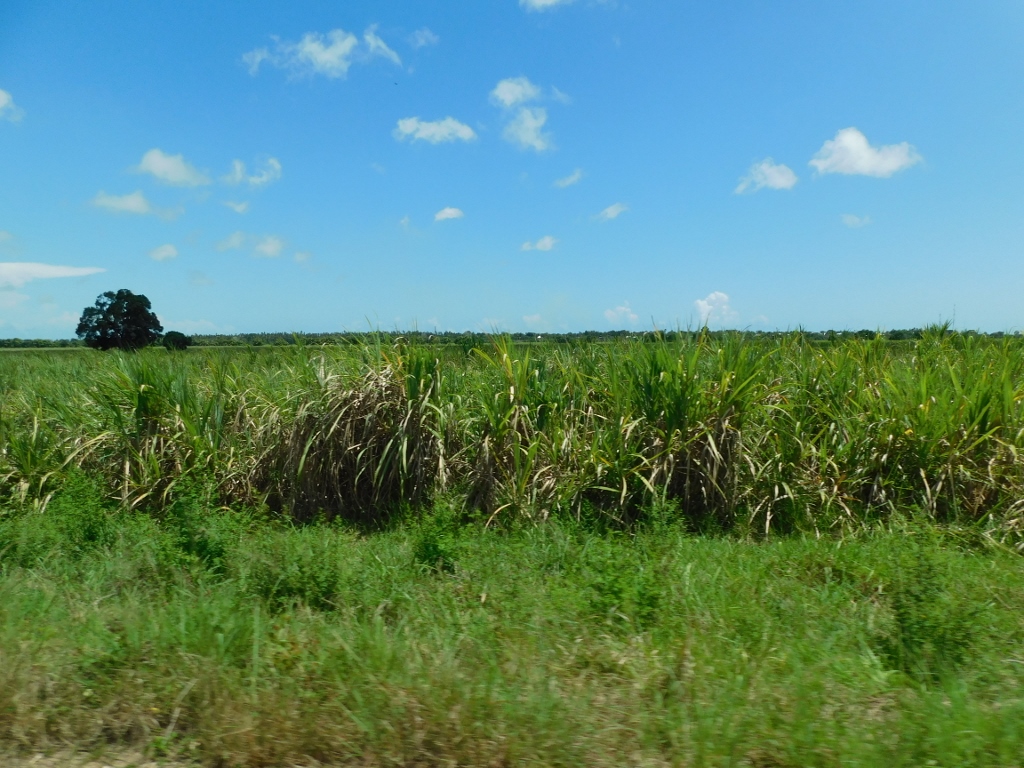 Sugar cane fields in Zanzibar
Sugar cane fields in Zanzibar
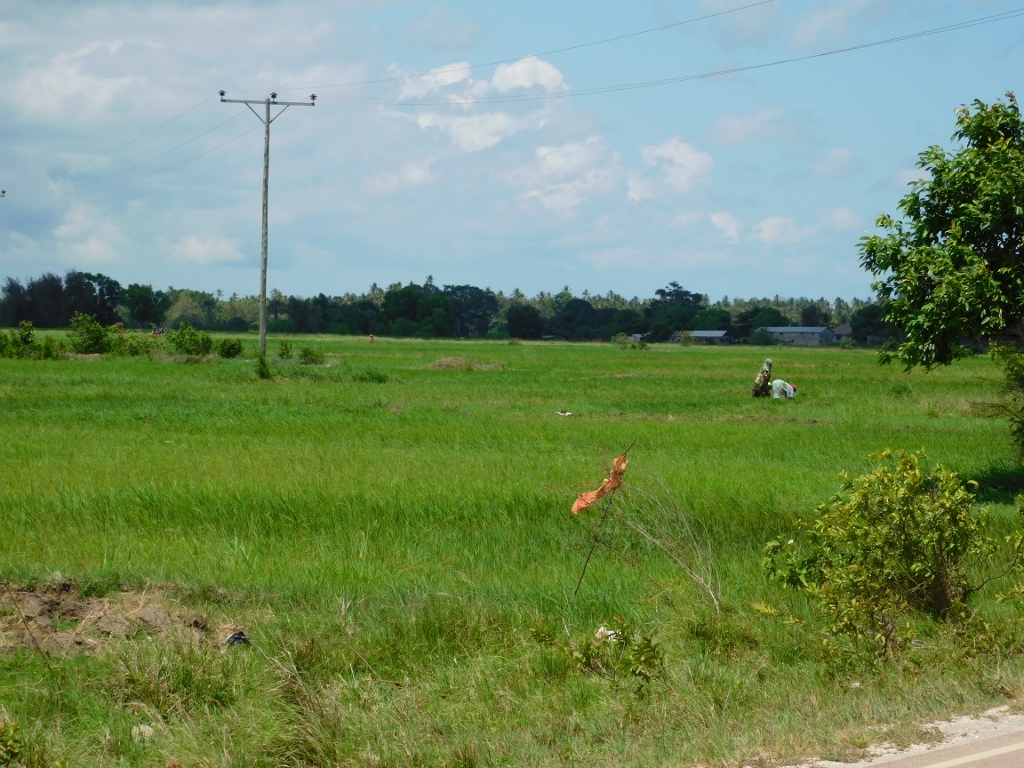 Rice fields in Zanzibar
Rice fields in Zanzibar
I suggested to the driver that we stopped at a “local place” for coffee and he chose it to be in the village of Dunga, where there is an intersection of a couple of important roads.
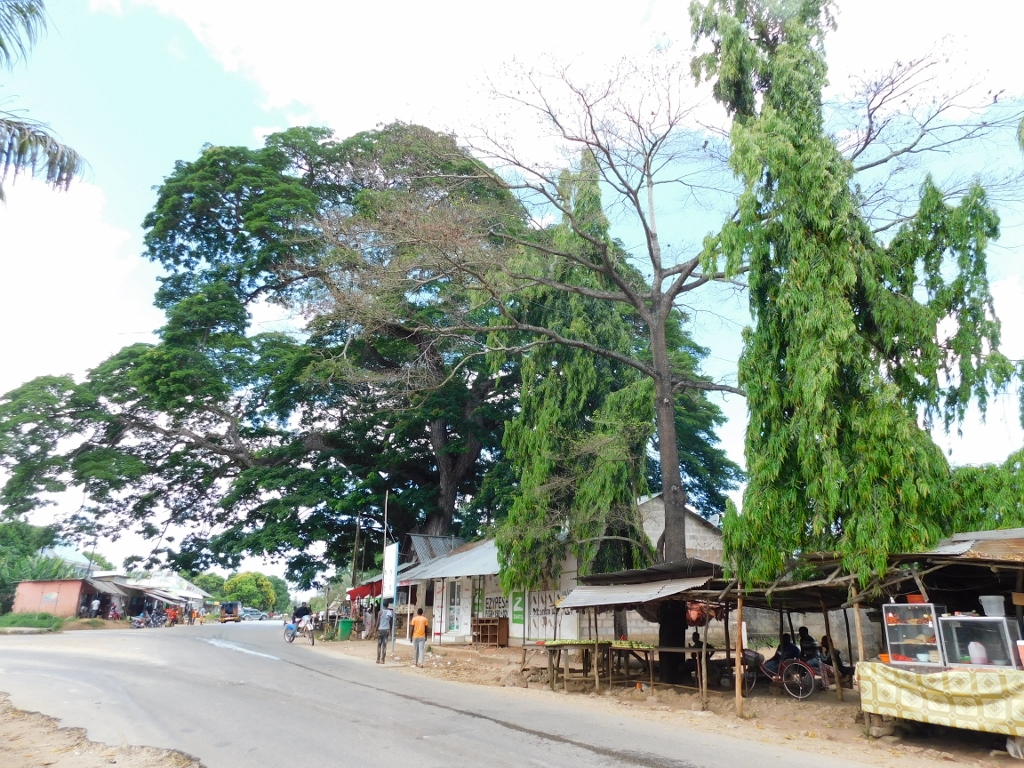 Village of Dunga
Village of Dunga
Next to the intersection there were several stands with vegetables, but there was also a man selling coffee that he had brought in a thermos.
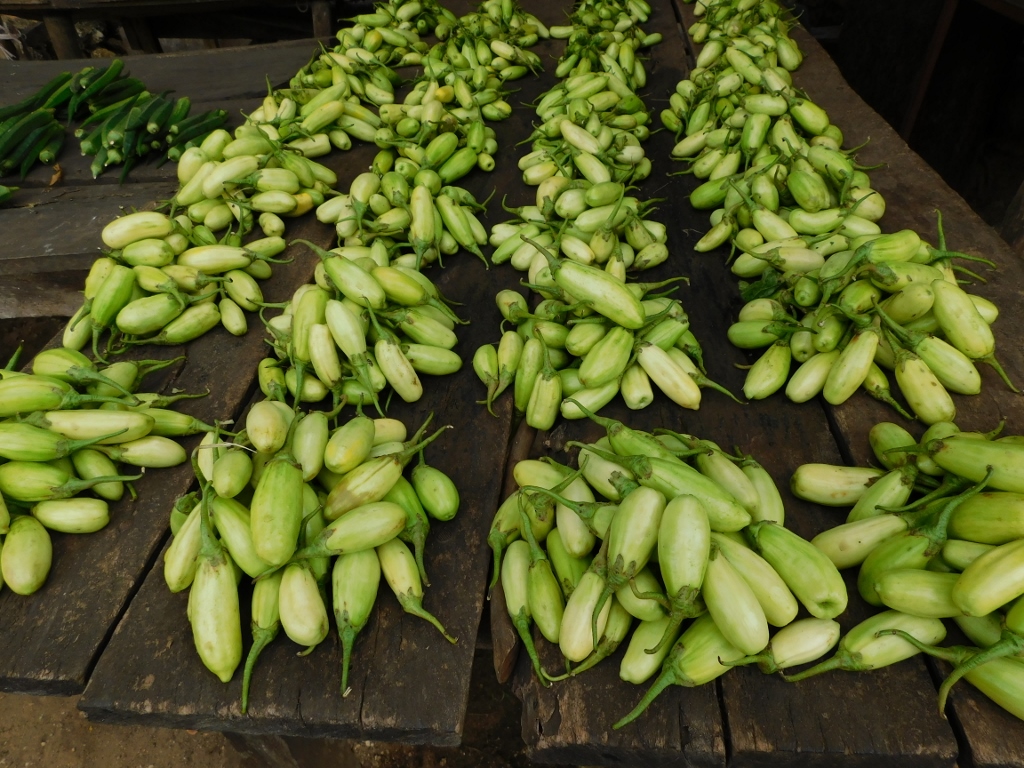 A part of the vegetable offer in Dunga village
A part of the vegetable offer in Dunga village
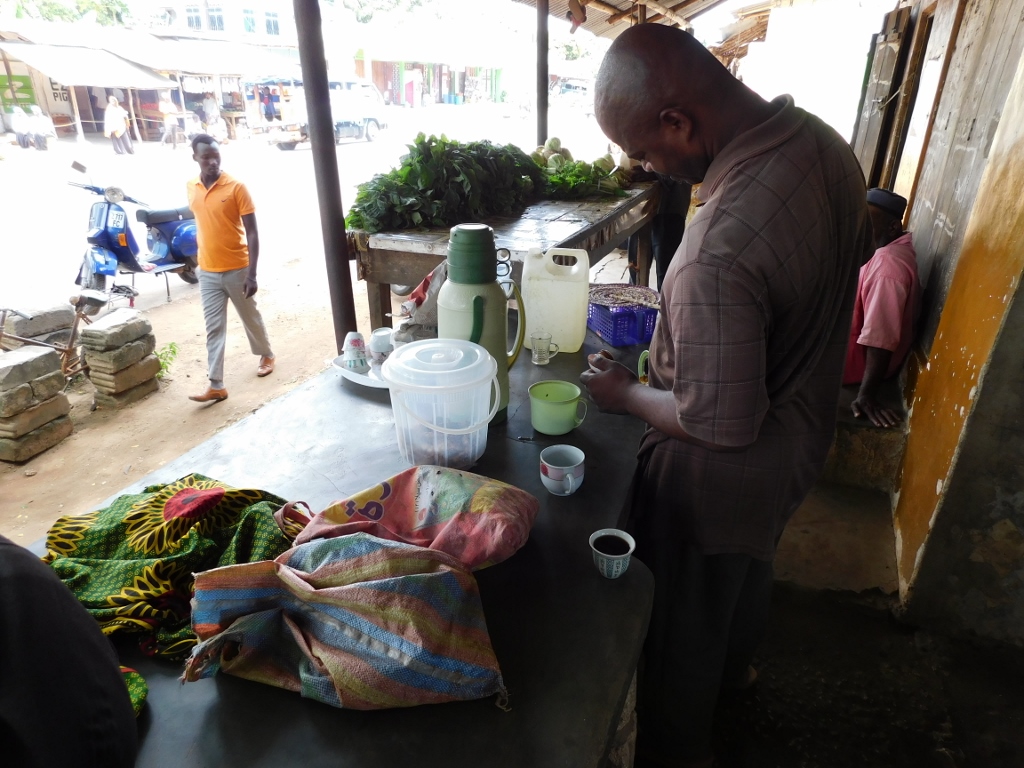 Local coffee shop
Local coffee shop
I sat down there, near the stand, on a built bench next to what looked like a semi-open waiting room for buses and I had my coffee. It was quite nice, so I took another one. Admittedly, my driver spoke very little English, so even though I wanted to pay for his coffee as well, I think I ended up paying only for my two. However, I found it interesting to observe the people around me and in fact, except for the man who was selling the coffee, it was not at all clear to me what the others were doing there.
On the other side of the street, I could see a pickup truck, which is called “dala-dala” and which is used for public transportation on Unguja, waiting for a few more passengers to appear before leaving.
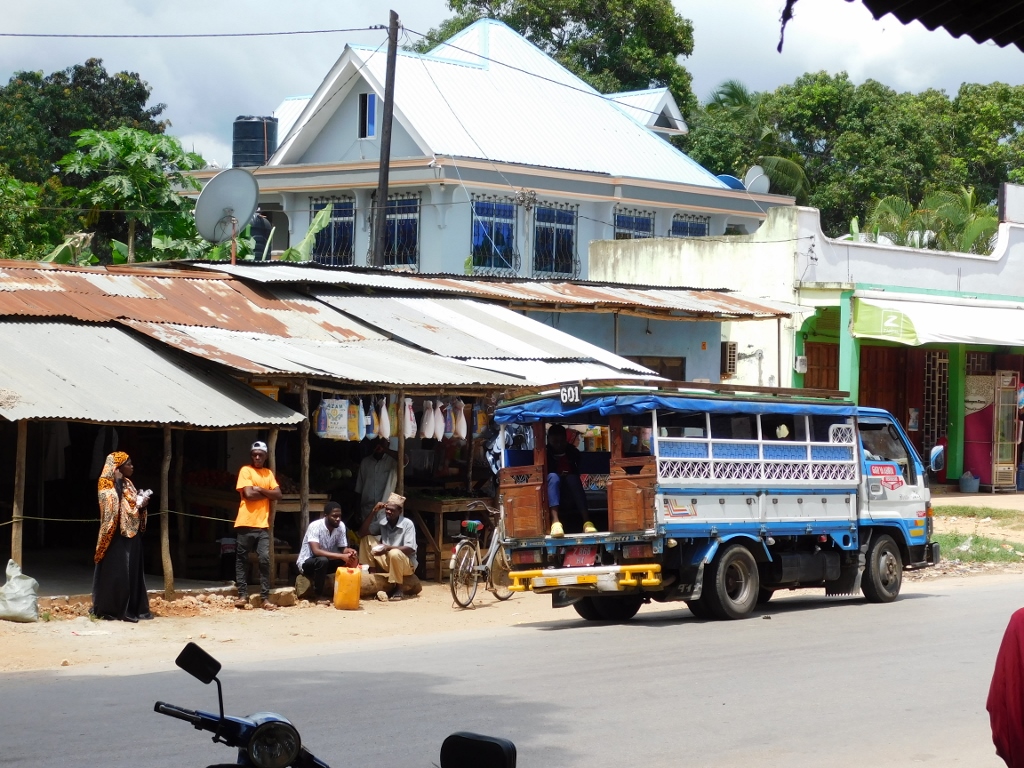 Detail from Dunga village
Detail from Dunga village
After I had finished with my coffee, I took a few more photos in the village and then we moved on, because we had to cover another 30 km in order to reach our final destination for the day.
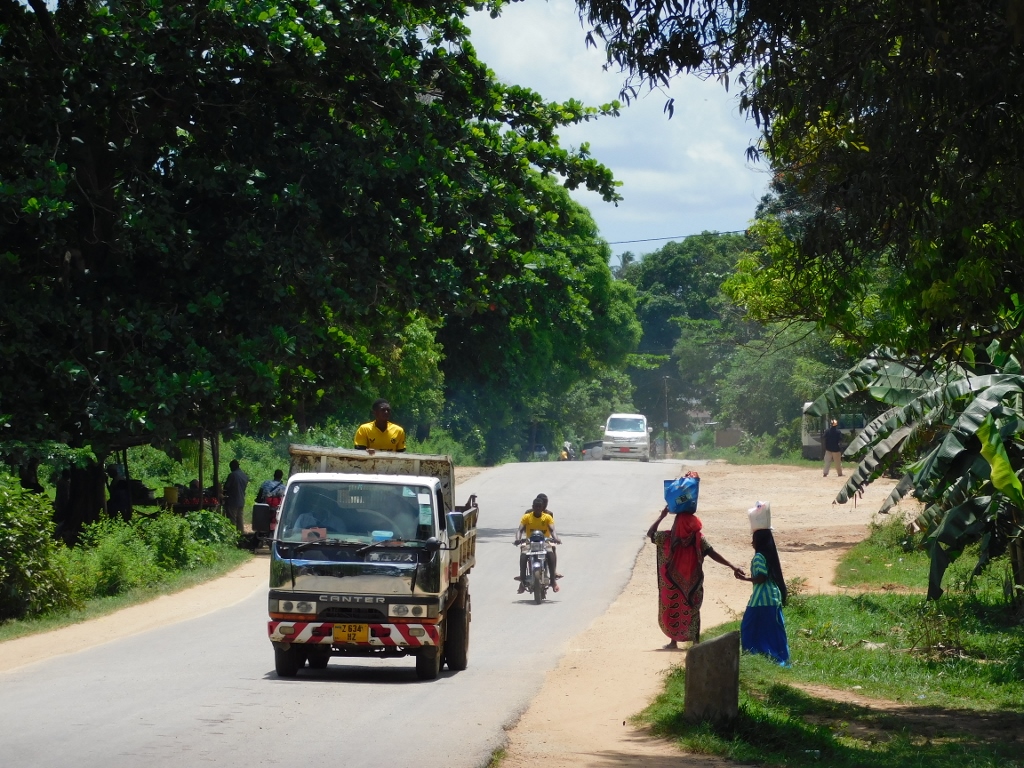 Detail from Dunga village
Detail from Dunga village
As I’ve already mentioned, this day I went to Jozani-Chwaka Bay National Park. It is the only national park in Zanzibar and it is inscribed on the UNESCO’s Tentative List. The reason for this is that this area, which includes the large Jozani Forest and the coastal zones belonging to the Chwaka Bay, is the habitat of numerous wildlife species, some of which have international and not only local importance.
Some of these species are endemic and some are close to extinction, so the preservation of the Jozani Forest is of great importance. I had encountered one such animal species before and its photo can be seen in part 3 of the travel stories about Zanzibar. It is Aders’s duiker (Cephalophus adersi) which is on the verge of extinction and I think the specimen I saw on Changuu Island is there to try to recover this species.
It is also said that there is the recently extinct Zanzibar leopard (Panthera pardus adersii) in the forest. In fact, even the experts aren’t sure if there is a single surviving specimen of the species, although some among them hope that humans haven’t quite annihilated them all.
An interesting endemic monkey species can still be seen without any major problems, although it is considered endangered. It is the Zanzibar red colobus monkey (Procolubus badius Kirkii).
My wish when coming here was to see a little bit of the forest and a little bit of that monkey.
To start with, the guide I “was assigned” alongside the entrance ticket took me through the forest. Of course, I only walked through a very small part of the forest, but it was still interesting.
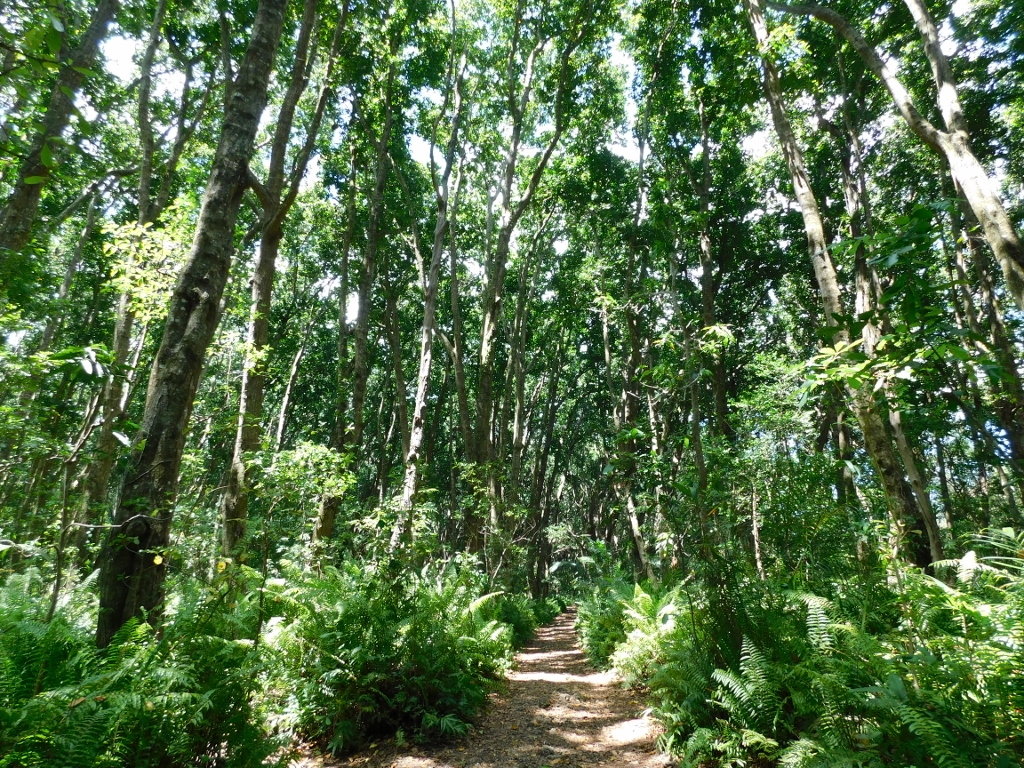 Jozani Forest
Jozani Forest
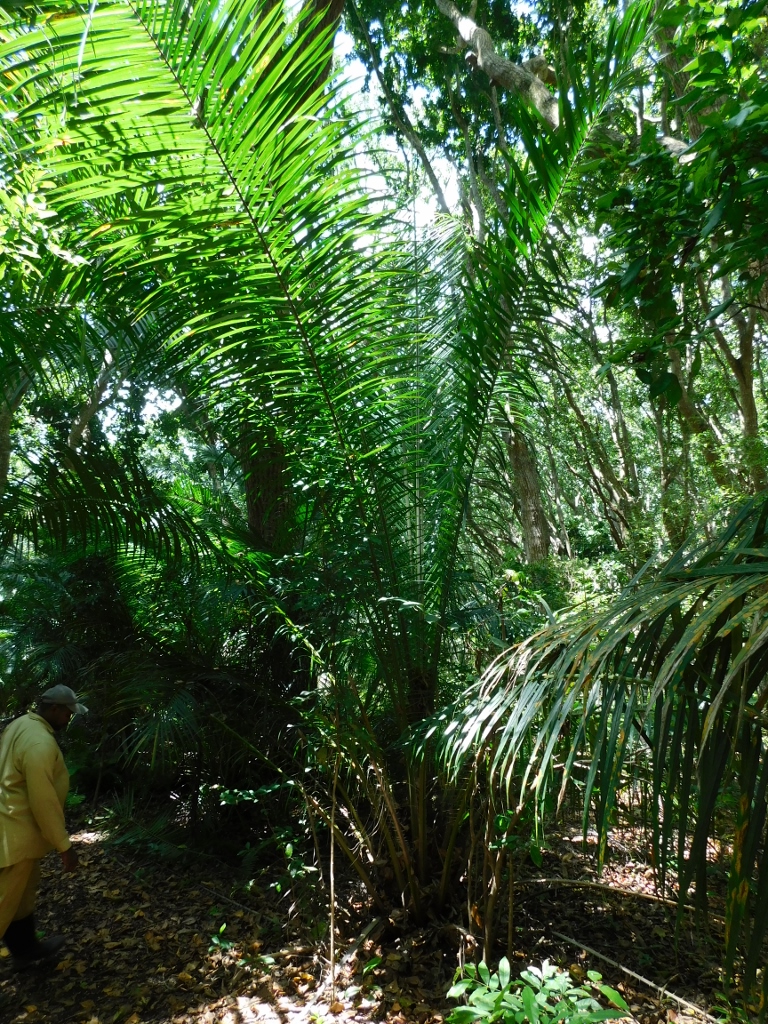 Jozani Forest
Jozani Forest
The forest is very beautiful, although it was clear from the condition of the path that I followed that I only saw the “tourist” part of the forest. Nevertheless, regardless of the fact that I did not run into a leopard, during the walk I had an encounter with a couple of harmless but interesting animals. One was kind and posed calmly while I photographed it, while the other was mischievous and moved relatively quickly on the branches of the trees, so I only took a partial photo of it.
The first was the yellow-headed dwarf gecko (Lygodactylus luteopicturatus) which is only about 8 cm long on average and the second is the blue monkey subspecies – Sykes’ monkey (Cercopithecus albogularis) which is also not too big. It usually grows to a length of a little more than half a meter.
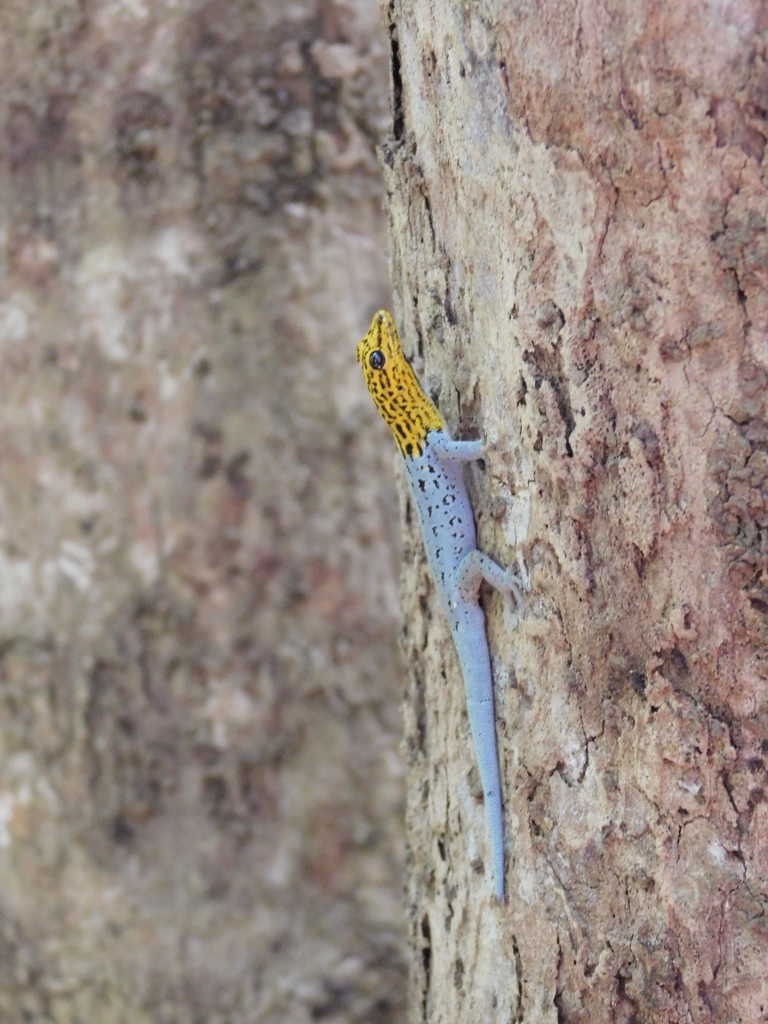 Yellow-headed dwarf gecko
Yellow-headed dwarf gecko
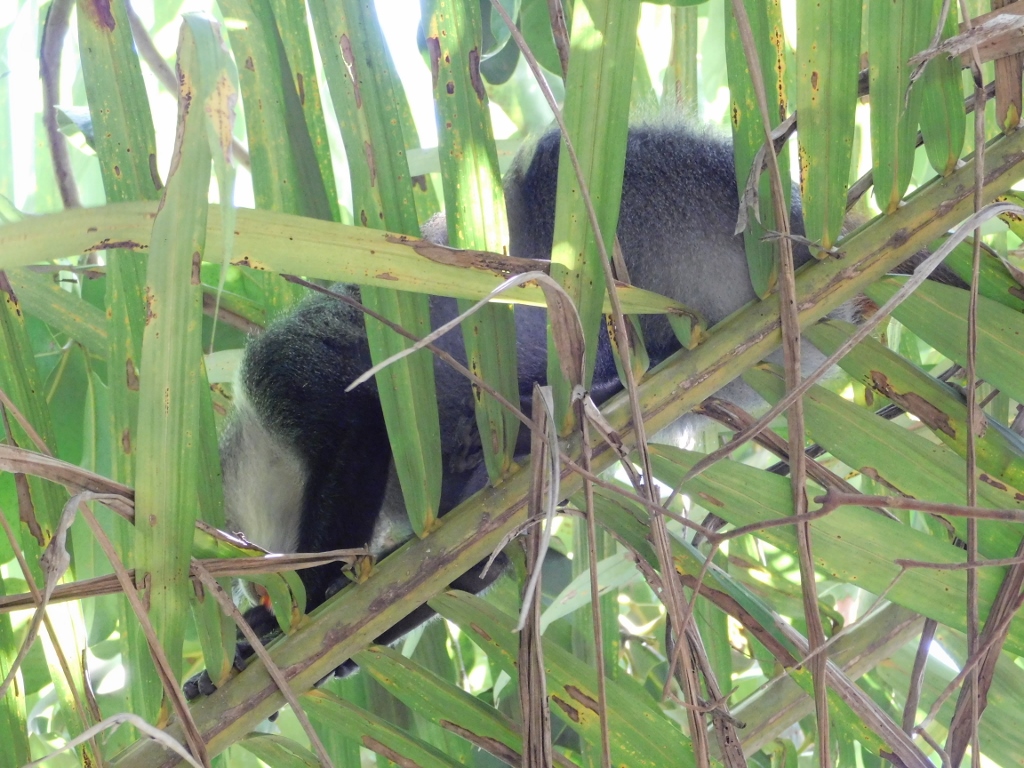 Sykes’ monkey
Sykes’ monkey
Although it was quite hot, since I knew I was going to be walking through a forest, I was well dressed with long pants and long sleeves.
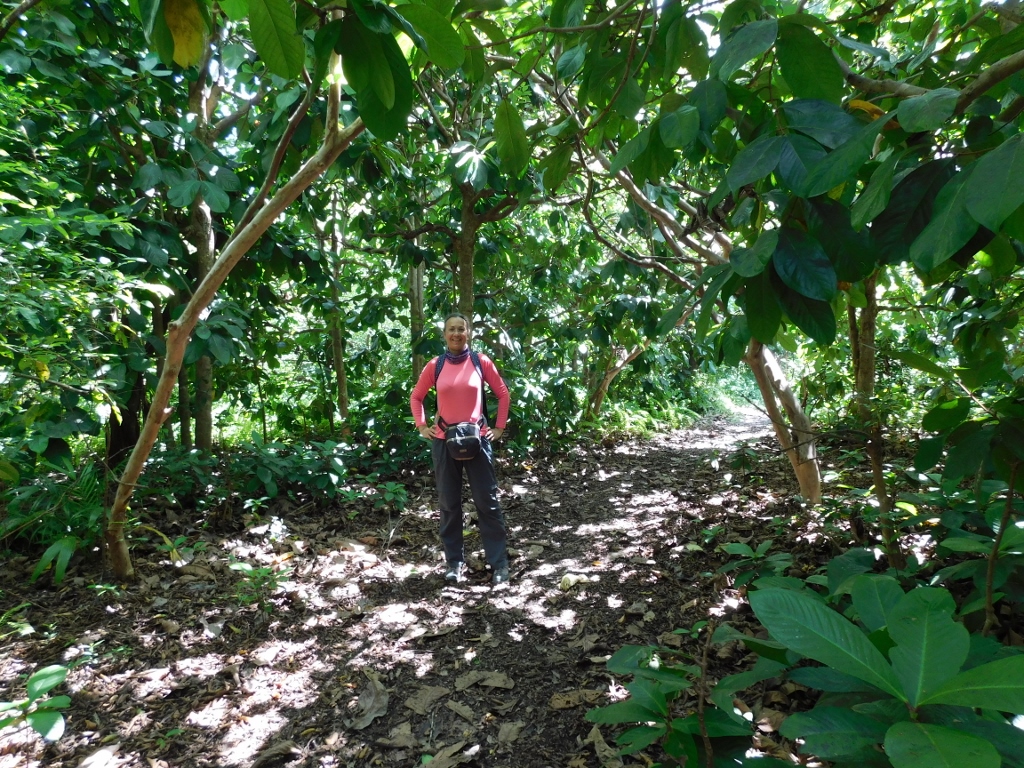 In the Jozani Forest
In the Jozani Forest
After a walk in this rather tame part of the forest, we crossed the main road that leads through the southern parts of the forest and went to look for special monkeys. At first it seemed that the search was fruitless, but then in a couple of places we came across Zanzibar red colobus monkeys (Procolubus kirkii) which are endemic to Unguja and which are classified as an endangered species. My impression was that the guides know exactly where these monkeys congregate and I assume that at least some food is left for the monkeys in such places, just to ensure that visitors can “run into” them.
However, in order to make the situation a little more dramatic, we first walked in vain for a while and only then did we see them.
To start with, there was a mom that was taking care of the hygiene of her baby.
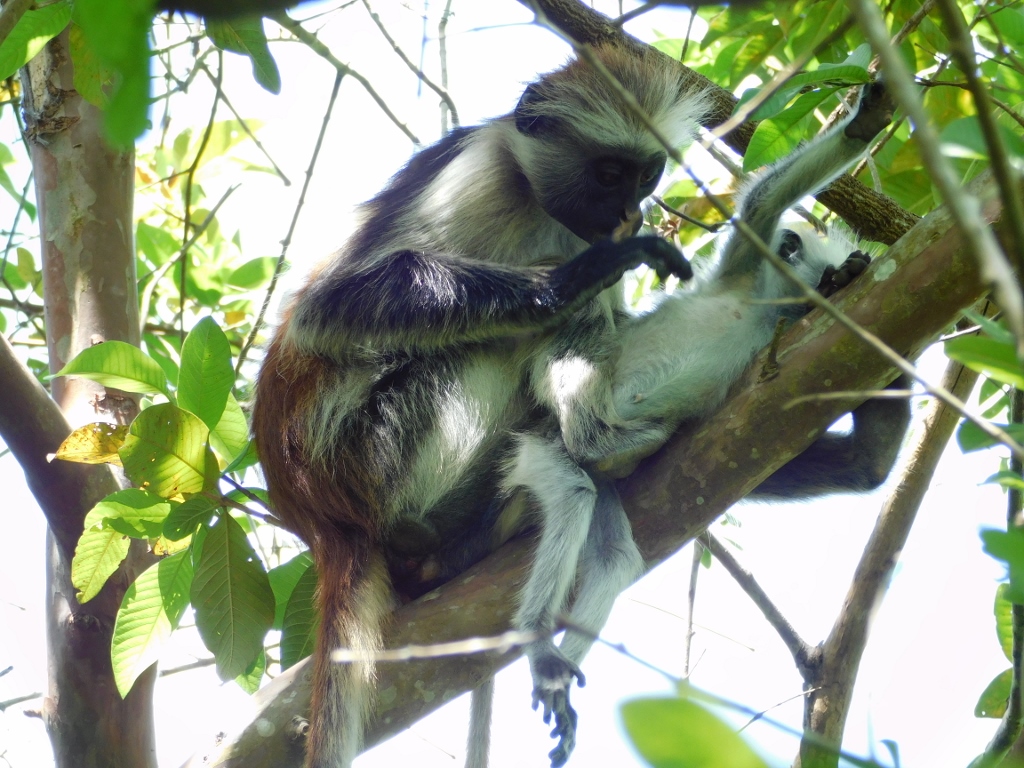 Zanzibar red colobus monkey
Zanzibar red colobus monkey
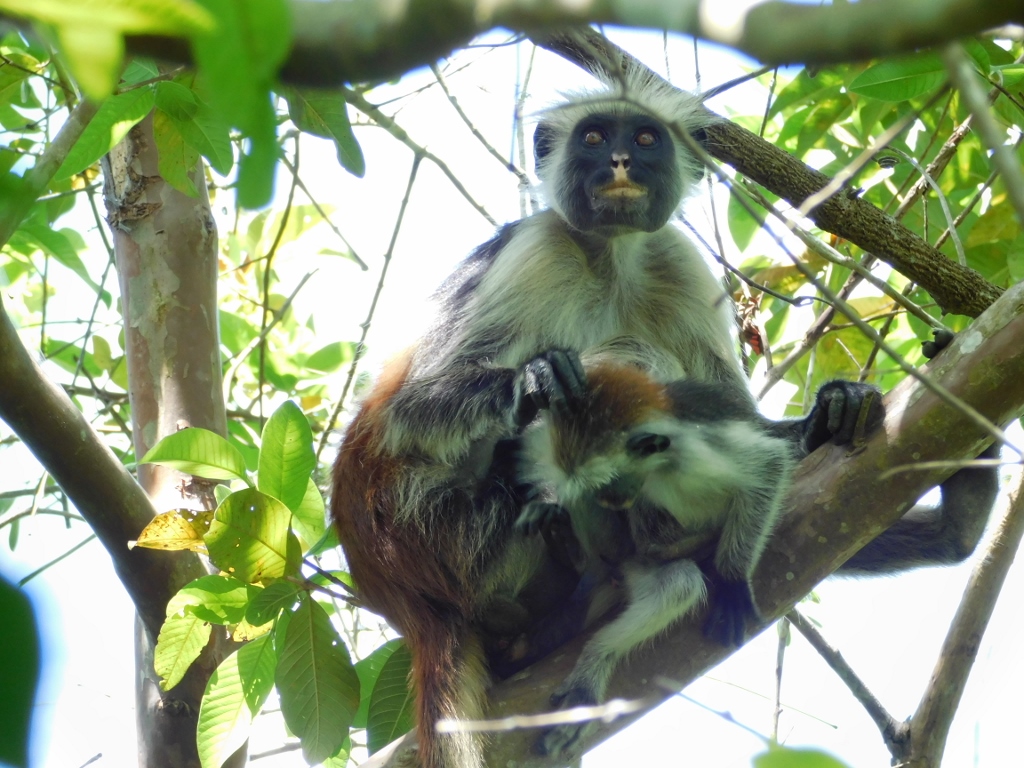 Zanzibar red colobus monkey
Zanzibar red colobus monkey
There was also one specimen nearby that looked like it was tired from the heat of the day, so it was resting.
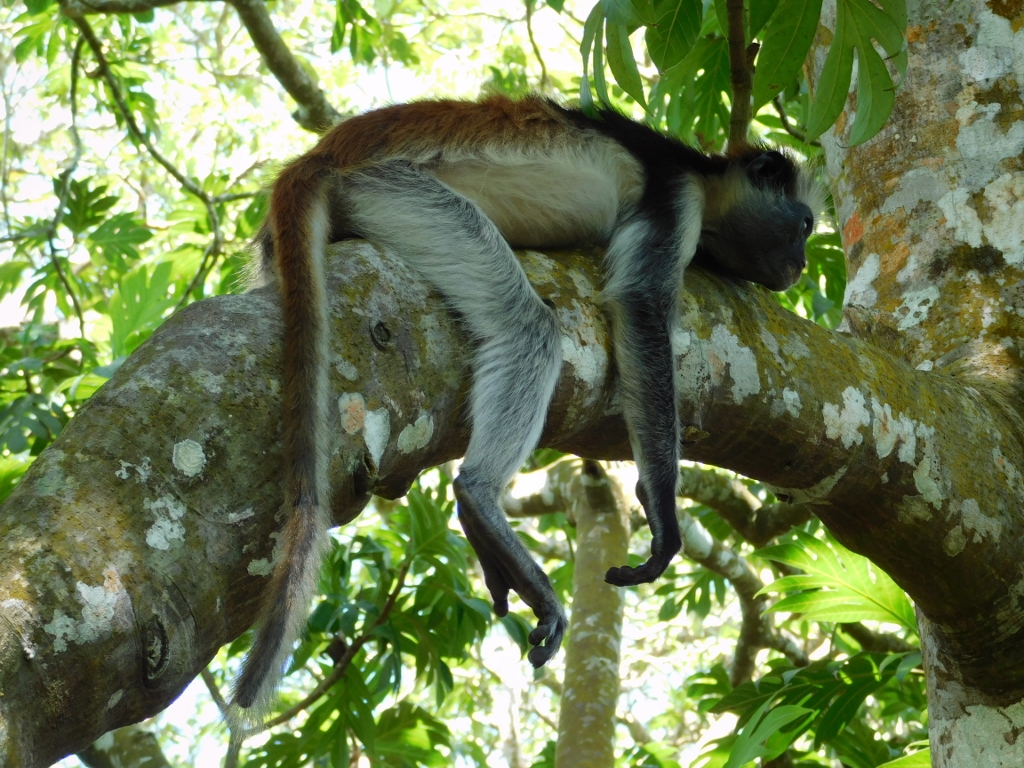 Zanzibar red colobus monkey
Zanzibar red colobus monkey
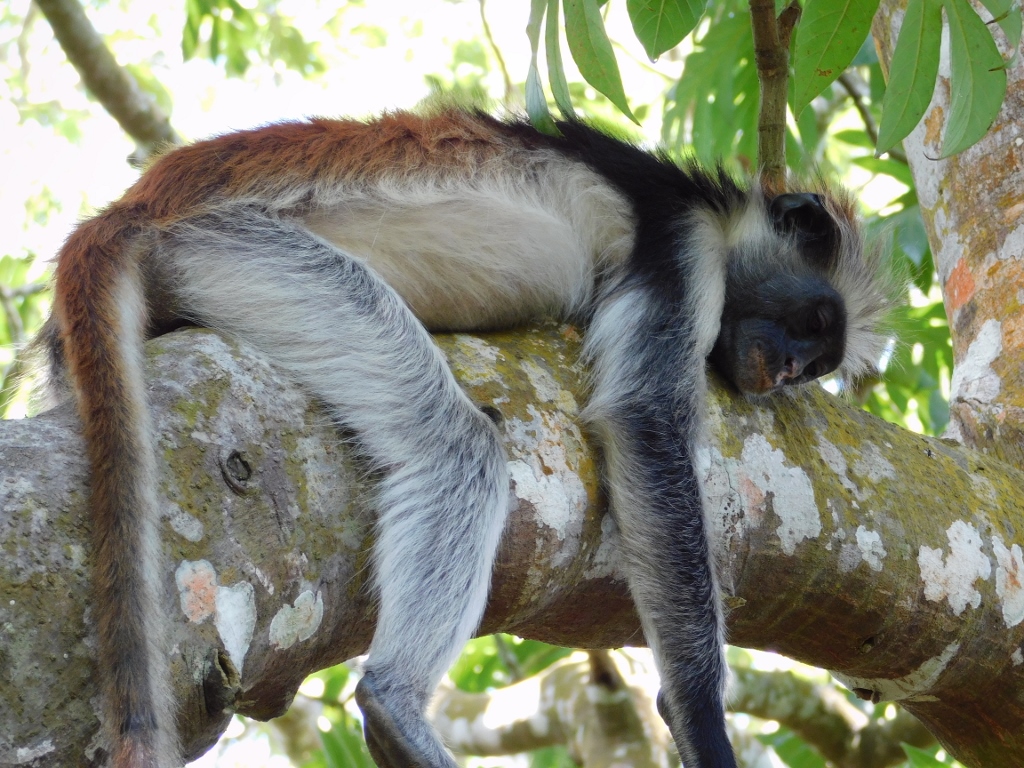 Zanzibar red colobus monkey
Zanzibar red colobus monkey
However, he did hear something, so got startled for a second.
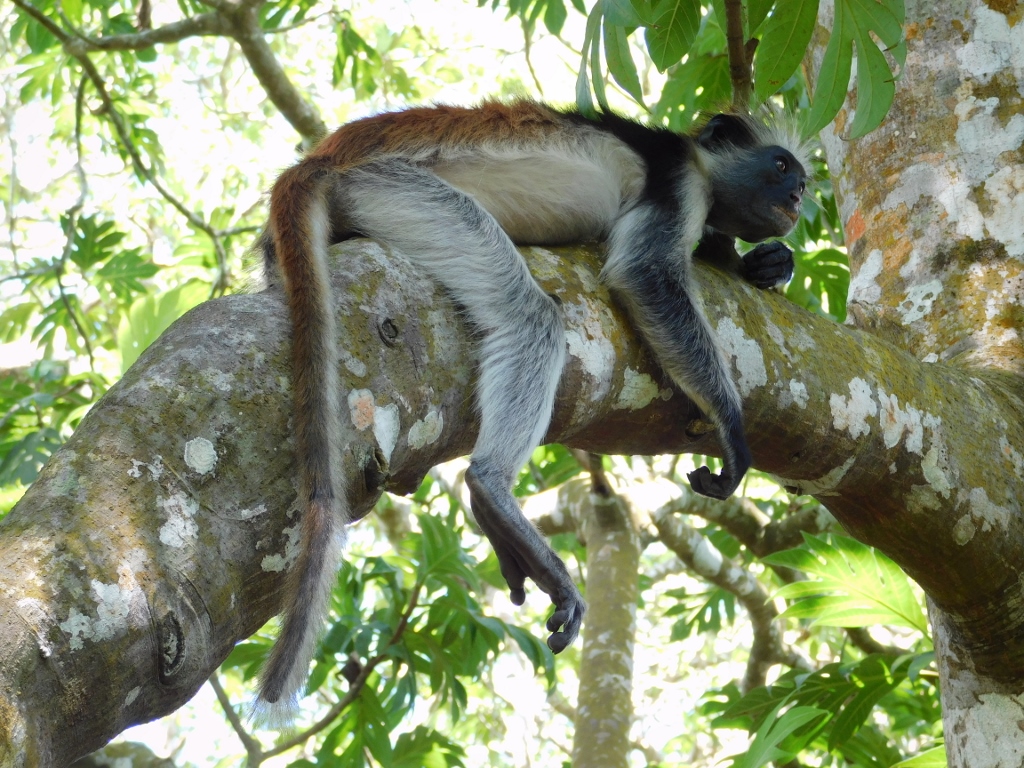 Zanzibar red colobus monkey
Zanzibar red colobus monkey
Then we came to a tree where there was a whole bunch of the Zanzibar red colobus monkeys.
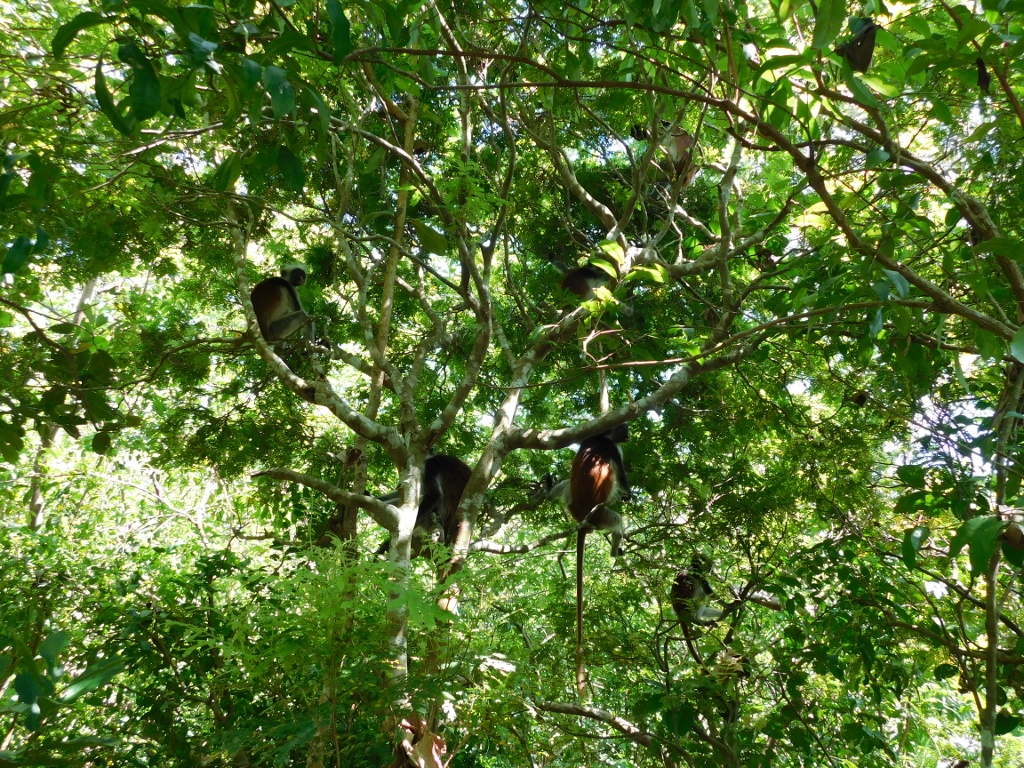 Zanzibar red colobus monkey
Zanzibar red colobus monkey
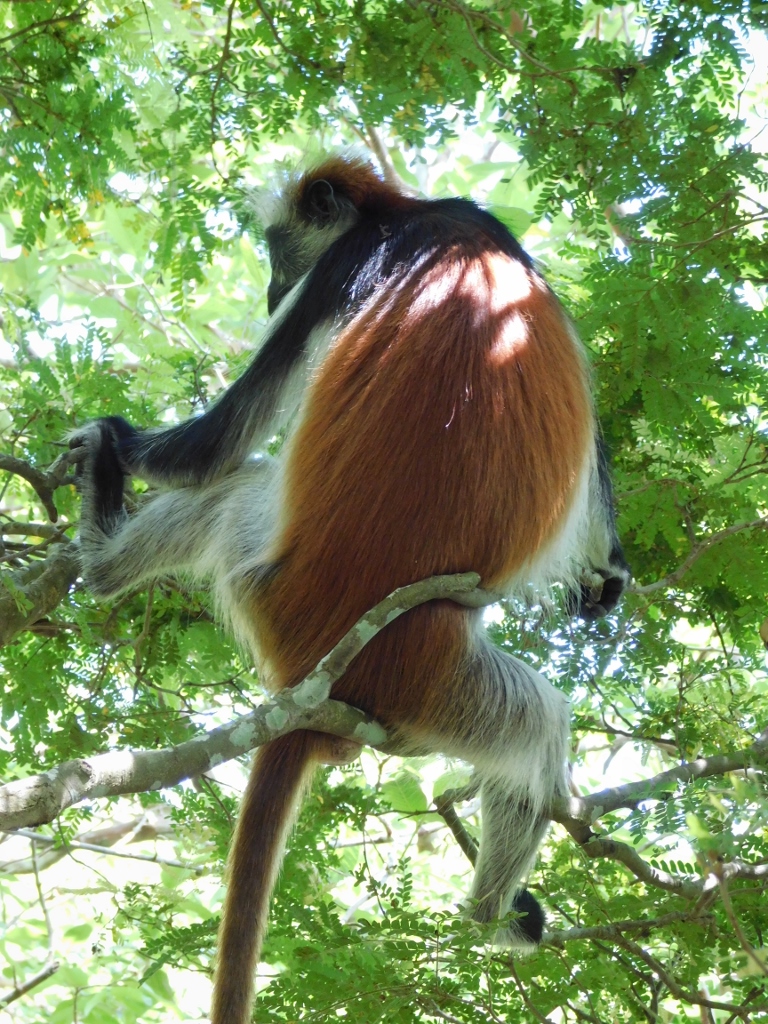 Zanzibar red colobus monkey
Zanzibar red colobus monkey
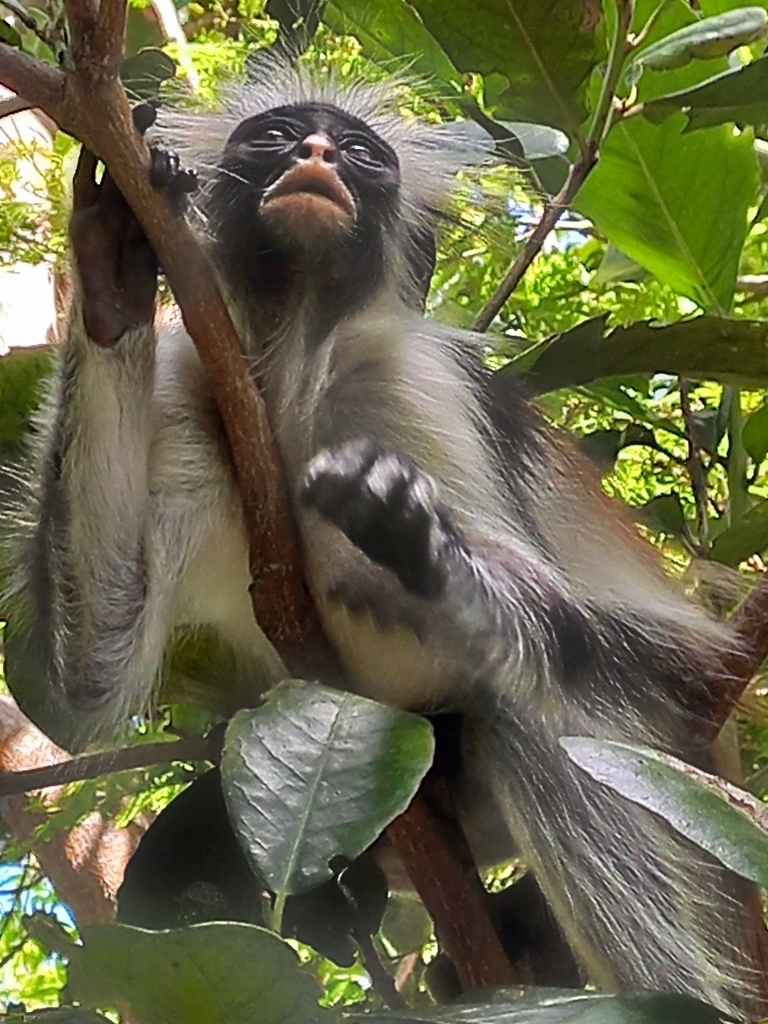 Zanzibar red colobus monkey
Zanzibar red colobus monkey
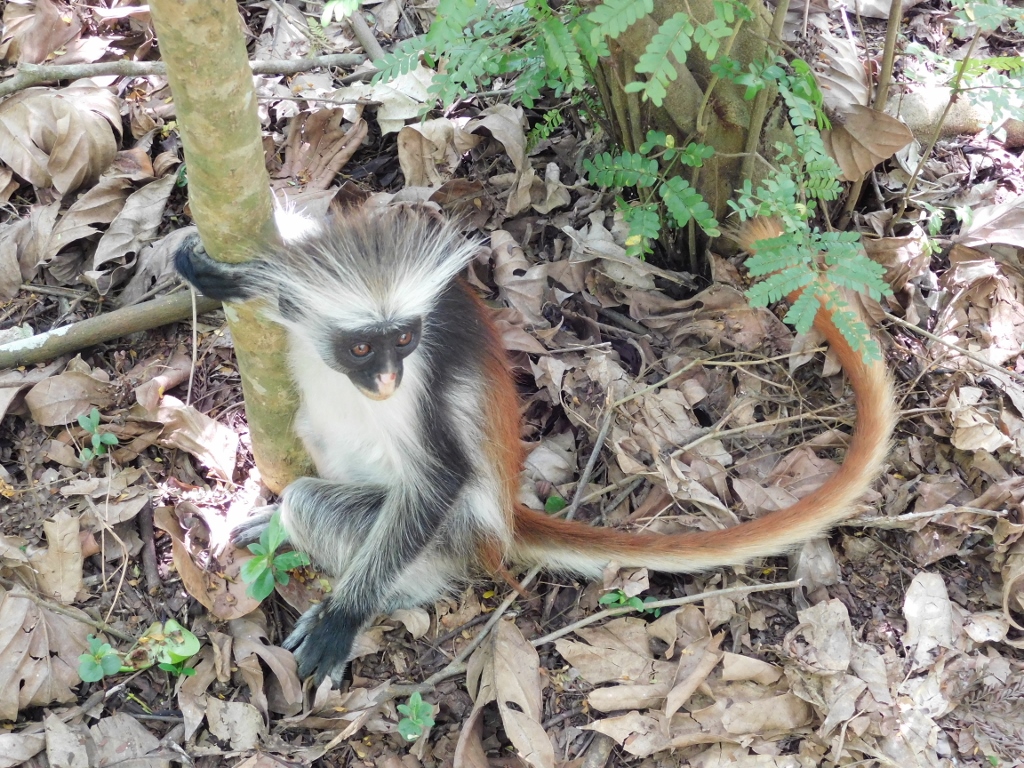 Zanzibar red colobus monkey
Zanzibar red colobus monkey
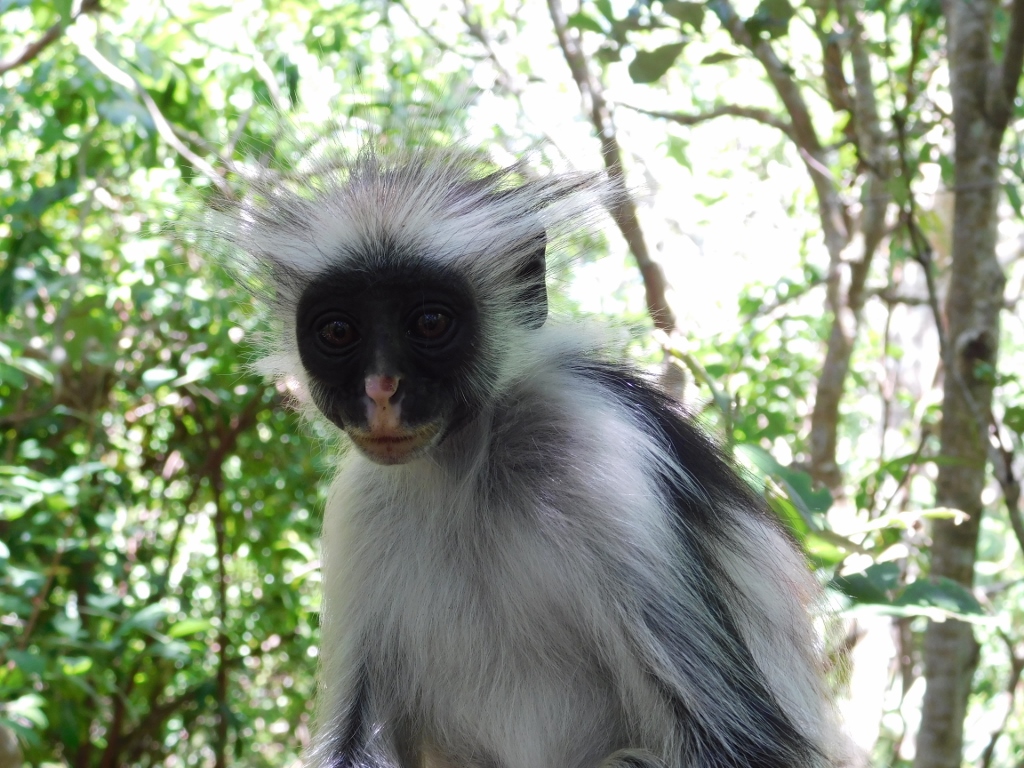 Zanzibar red colobus monkey
Zanzibar red colobus monkey
I recorded the Zanzibar red colobus monkeys using both my video camera and my mobile phone, but on this day I had some problems deciding whether I wanted to use portrait or landscape orientation. Hence the two videos:
I would also like to add that the Visitor Centre expressly emphasises that these monkeys should not be fed or approached too closely, bearing in mind their status as an endangered species, so it is important that they have as little contact with people as possible. However, I had the impression that this is not the case in practice. Probably because he expected a tip, the guide offered to me (and I’m sure other guides do the same) to make a monkey stand on my shoulder and then he would probably take a photo of me. I refused because I really wasn’t in the least interested in that and I certainly wouldn’t even want to think that our close encounter could endanger a colobus monkey in any way.
After this we went to a side road in order to go for a walk through a mangrove forest, but to begin with I found it interesting to see some slender and tall palm trees growing by the side of the road.
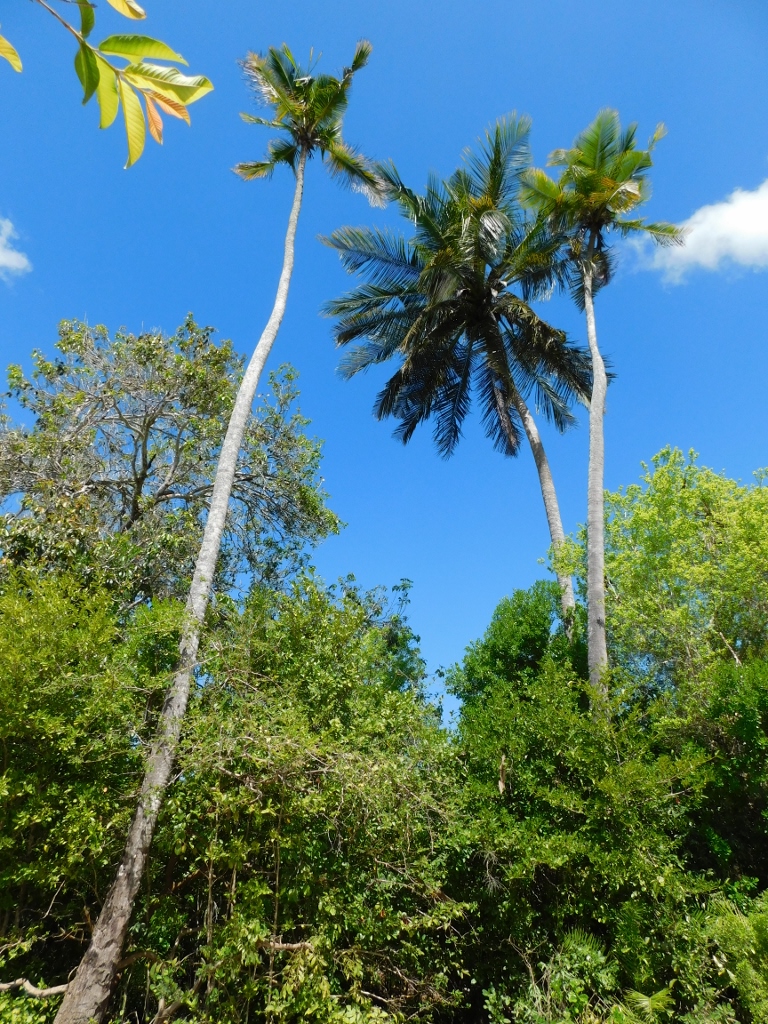 Vegetation on Unguja
Vegetation on Unguja
Formally speaking, the mangrove forest through which the walk was planned is not a part of the Jozani Forest, but it is a part of the national park. The forest is fed by the water that gets there from a narrow bay in the south of the island of Unguja and some wooden footpaths have been constructed at a sufficient height, which allows the mangroves to be viewed from up high, i.e., the paths are made above the maximum level reached by water during high tide.
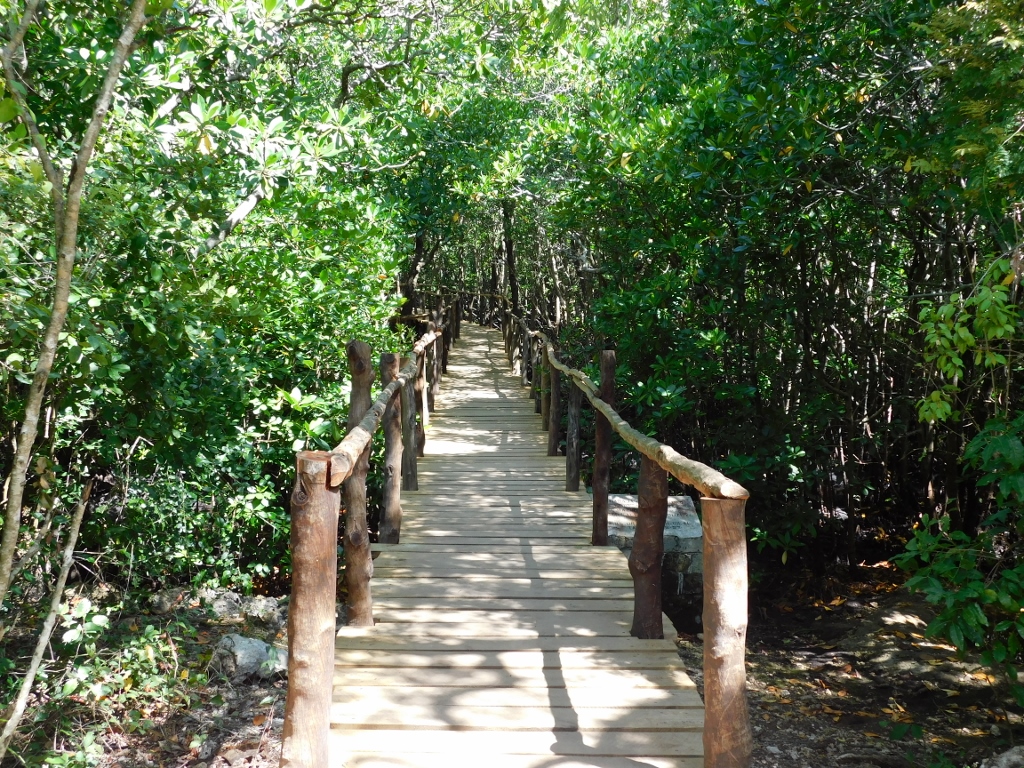 Entrance into the mangrove forest
Entrance into the mangrove forest
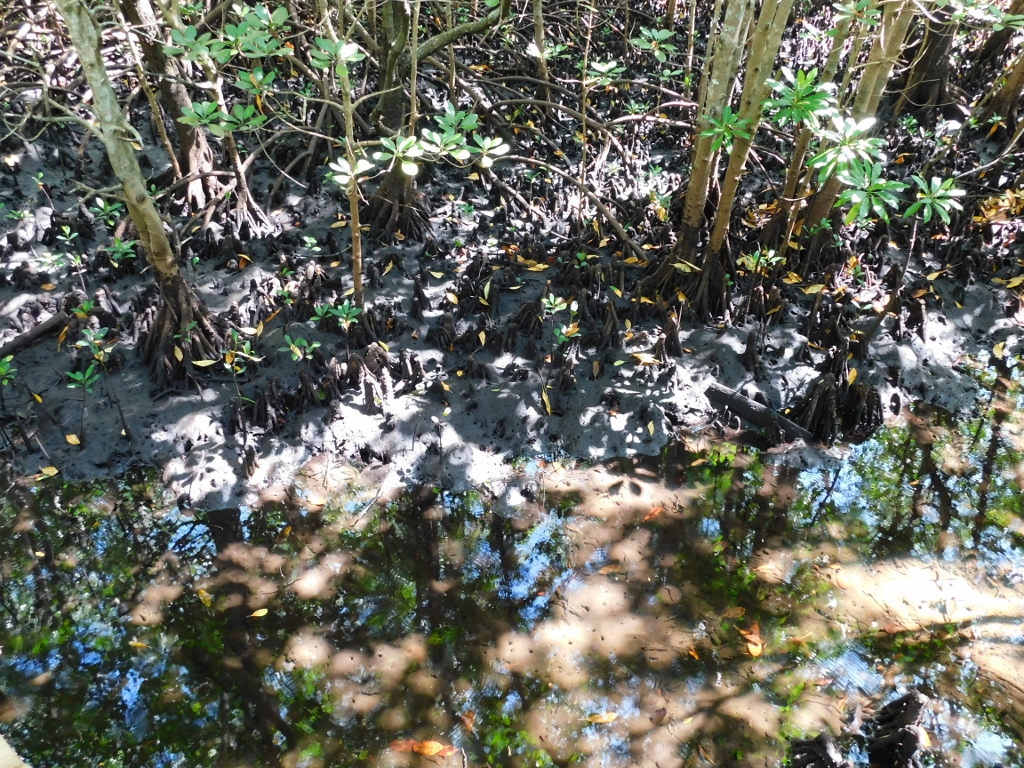 Mangrove forest during low tide
Mangrove forest during low tide
Since it was the time of low tide, I could notice a small crab.
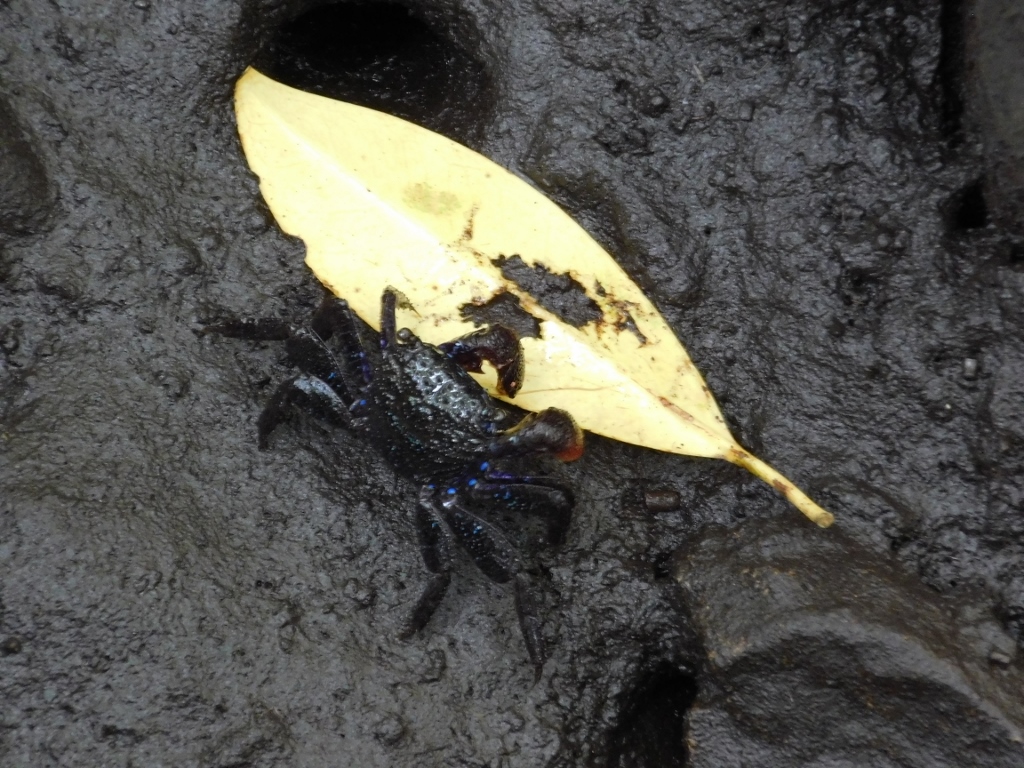 Resident of the mangrove forest
Resident of the mangrove forest
Mangroves are plants, something between bushes and trees, which in tropical and subtropical areas grow on muddy ground in the immediate vicinity of the sea, so they are adapted to life in saline or brackish waters. With their roots, mangroves create an ideal habitat for the reproduction of marine organisms, including fish that normally live in the open sea, where they can easily hide from predators. Mangroves are also suitable for the life and breeding of birds.
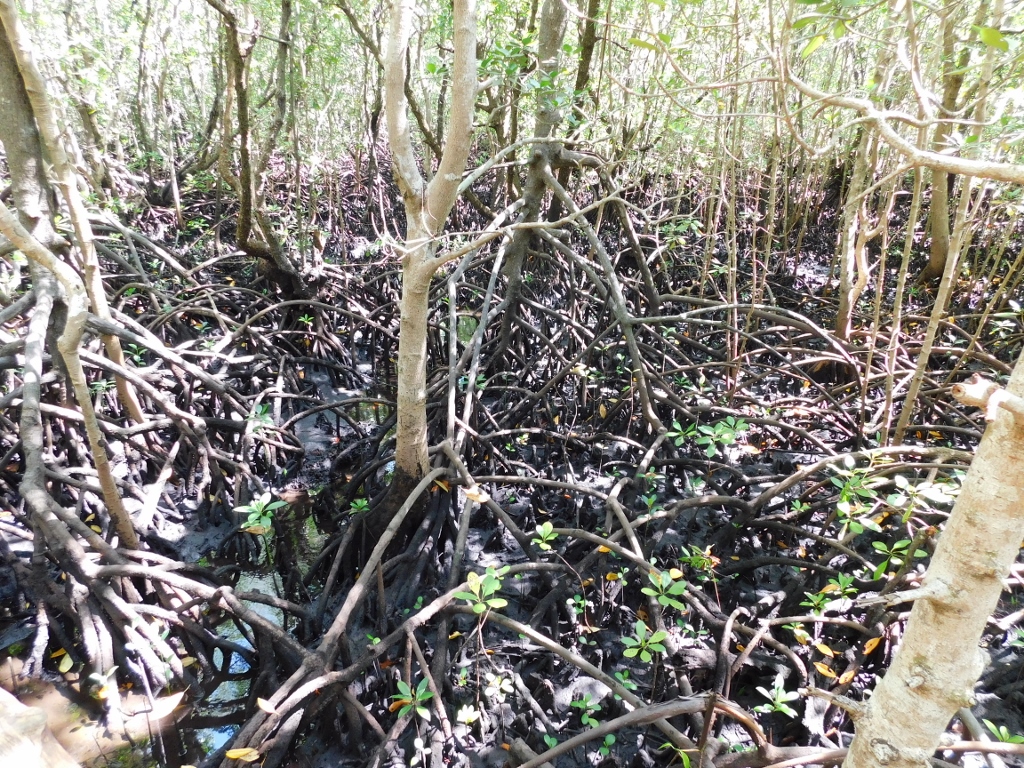 Mangrove forest
Mangrove forest
During the walk, you pass over a couple of canals and the visual effect was very beautiful.
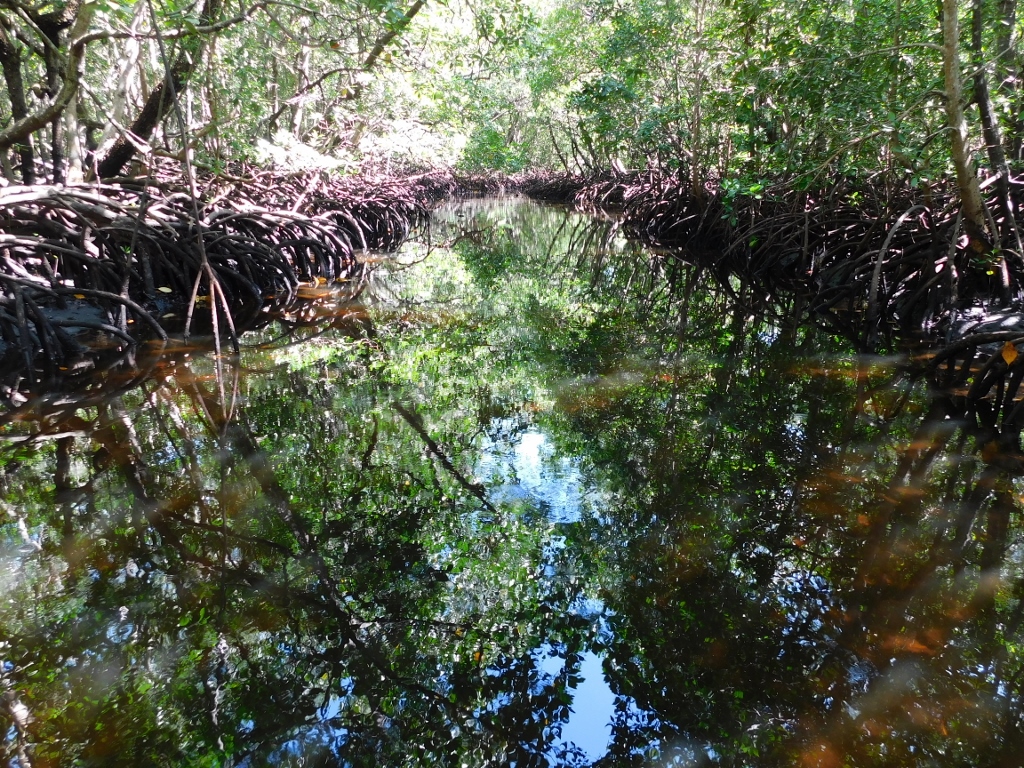 Mangrove forest
Mangrove forest
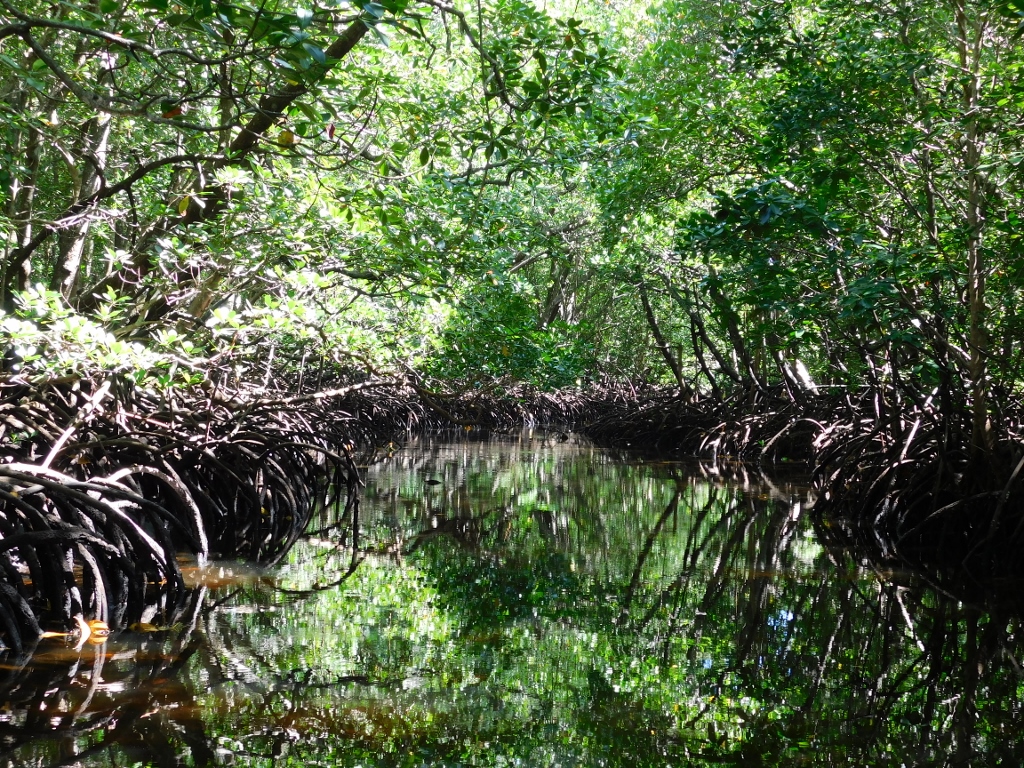 Mangrove forest
Mangrove forest
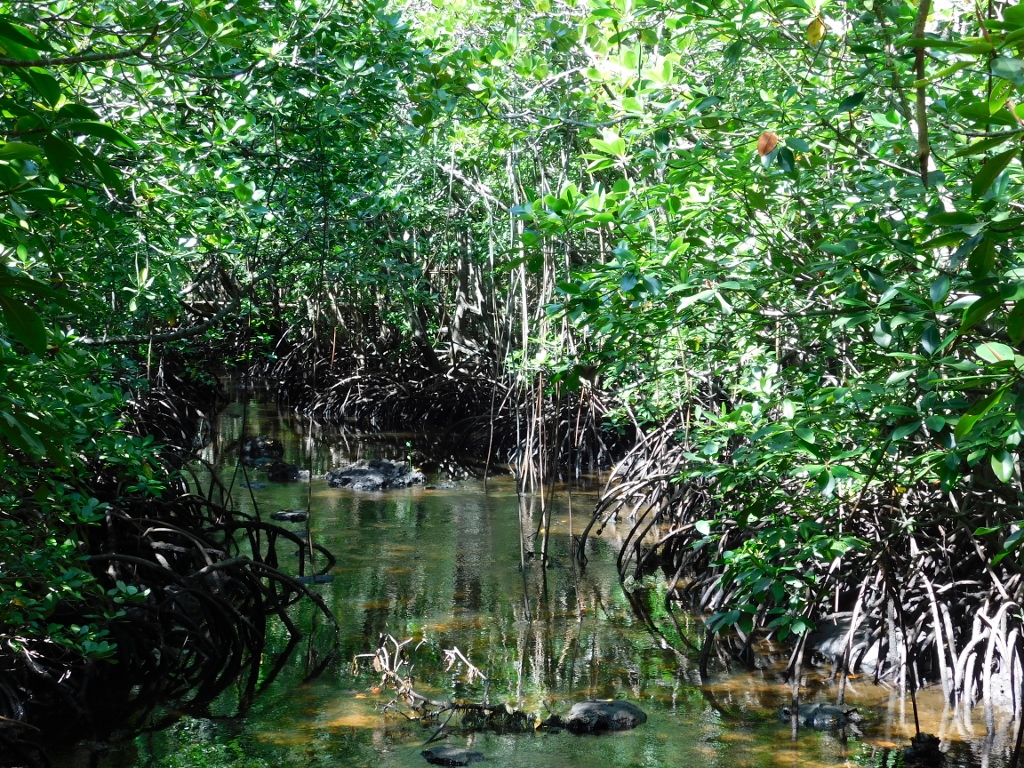 Mangrove forest
Mangrove forest
I ended my visit to the Jozani-Chwaka Bay National Park with this walk through the mangrove forest, so I returned to the parking lot at the Visitor Centre where the driver was waiting for me with the car. Now I focused again on the sights alongside the road we used in order to return to the north and the village of Nungwi.
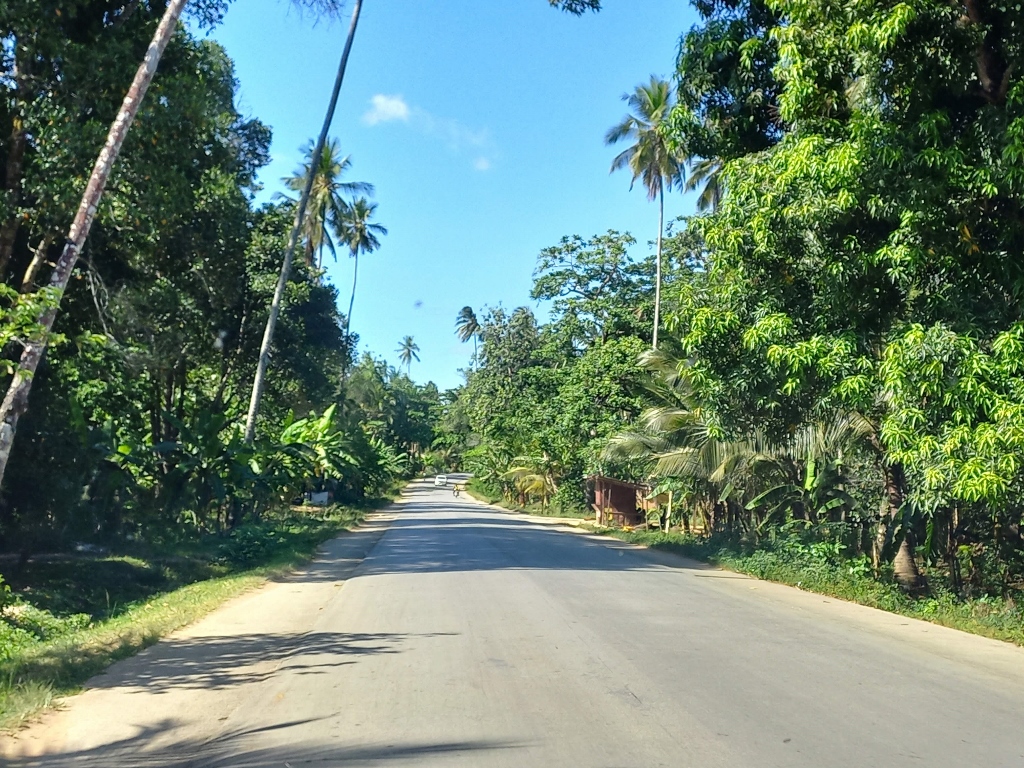 Zanzibar
Zanzibar
But now it was also interesting for me to deal with fruit. I took a photo of a large mango tree growing beside the road and having fruits that were still under-ripe, although there were obviously birds enjoying the mangoes even before they were fully ripe.
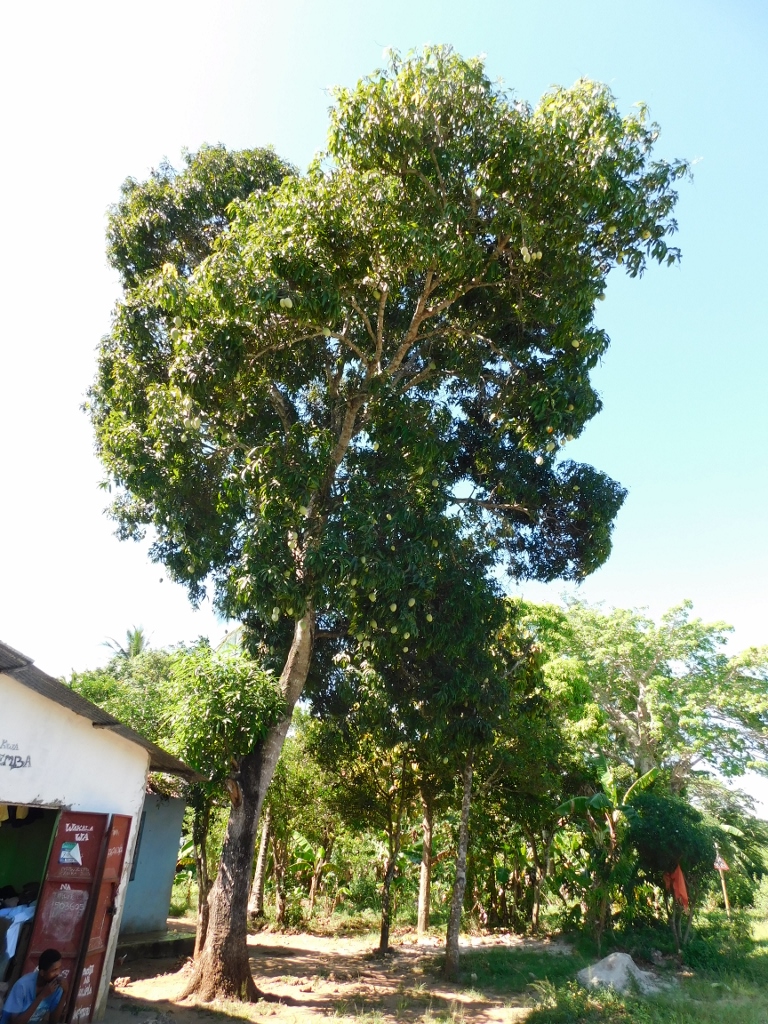 Mango tree
Mango tree
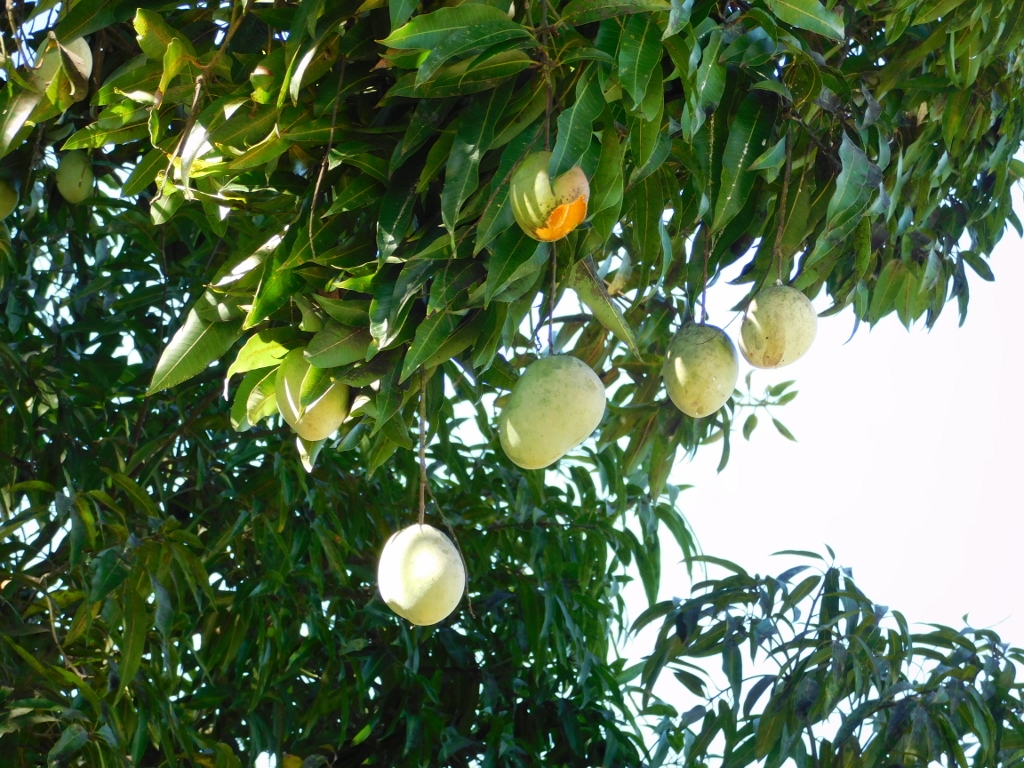 Mango fruits
Mango fruits
I had no intention of climbing the trees in order to get fruit, but I took advantage of the presence of roadside stalls to buy one of my favourites, passion fruit, and of course there were also wonderful bananas, which here have a huge advantage over those bought in supermarkets. These here ripe naturally.
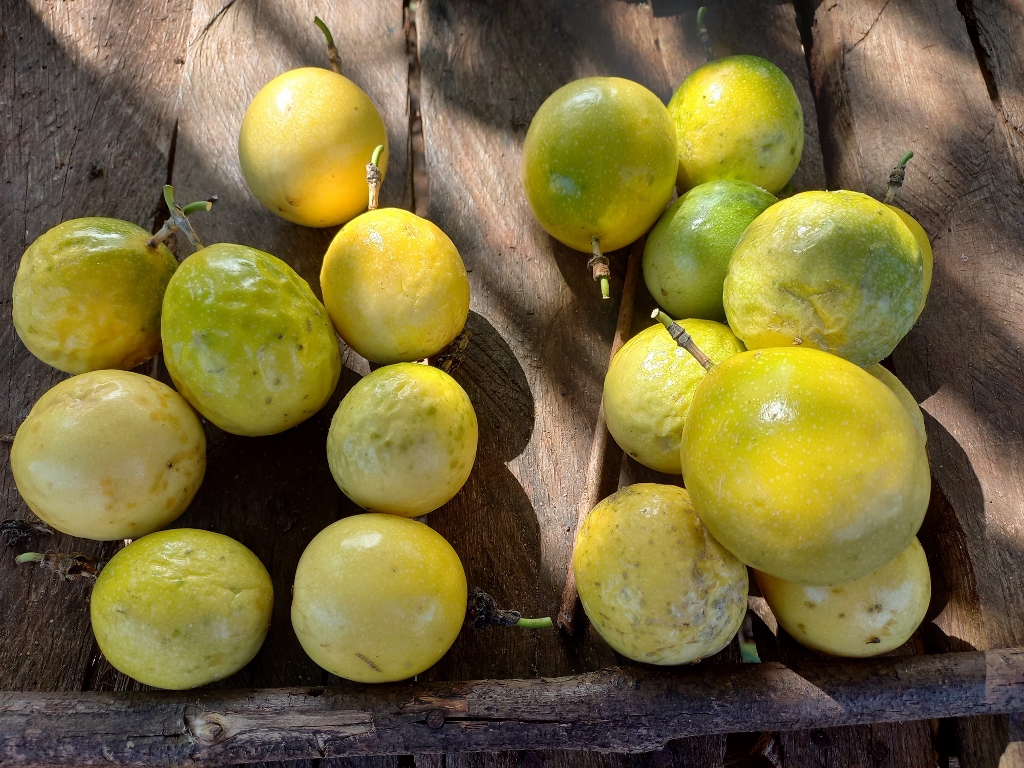 Passion fruit
Passion fruit
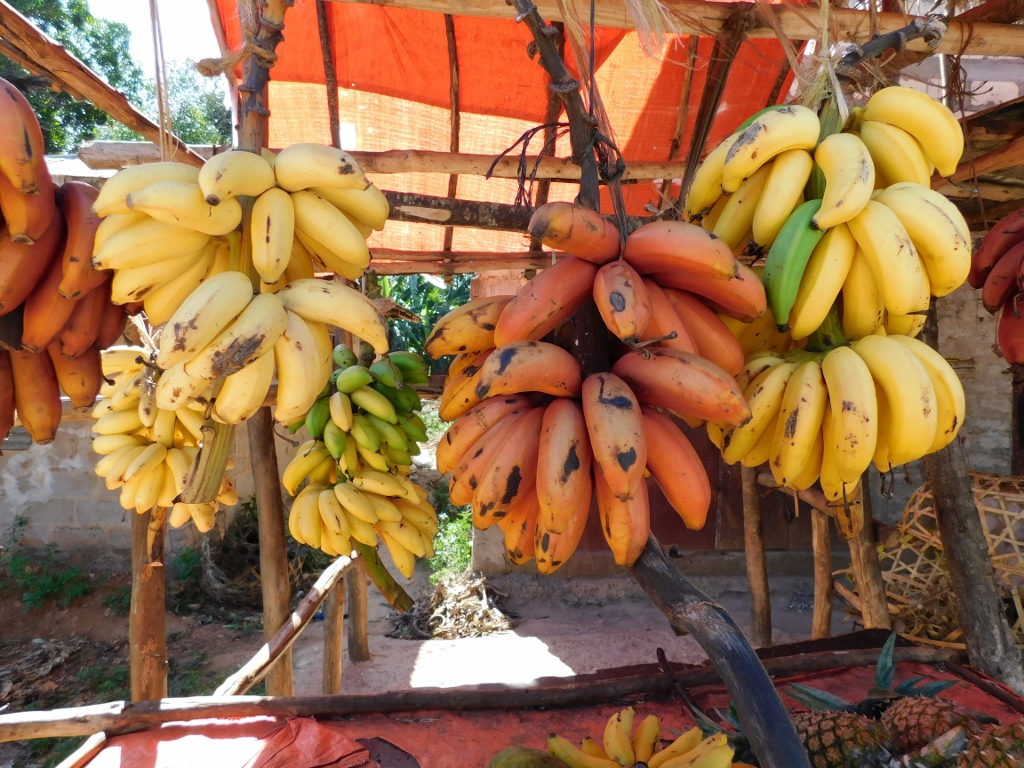 Bananas
Bananas
While I was buying bananas and the young man who was selling them was cutting off a smaller bunch I told him I wanted, his friend who was somewhere up on the scaffolding of the house being built there kept throwing some comments cheerfully. It was fun and they both allowed me to take their photos. Here is a video that shows how bananas are cut from a larger branch, but also a photo of these funny and certainly very beautiful young men. In general, I had the impression that the inhabitants of Zanzibar are very beautiful, both men and women.
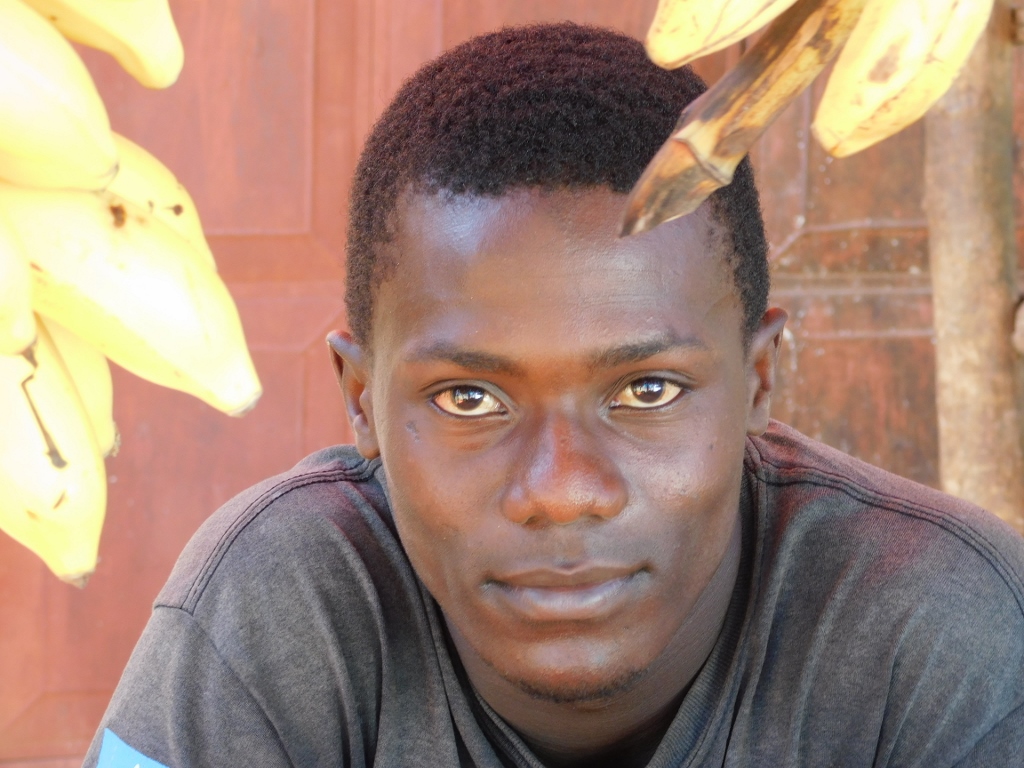 Guy from Zanzibar
Guy from Zanzibar
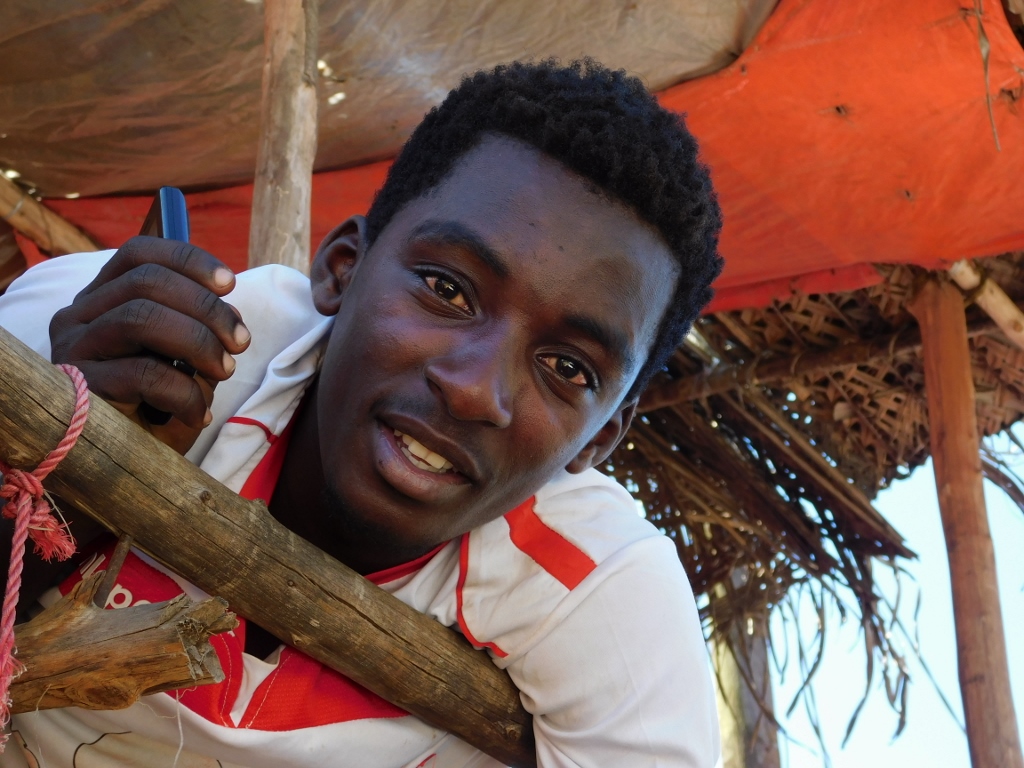 Guy from Zanzibar
Guy from Zanzibar
I spent the rest of the day leisurely, on the beach and around the hotel where I was staying. At some point, I ate, but I also had a refreshing drink on the hotel’s terrace. The appearance of the drink should not be misleading. There was fresh fruit juice, but there was also some alcohol. And all of this feels fine and enjoyable, when one is on vacation.
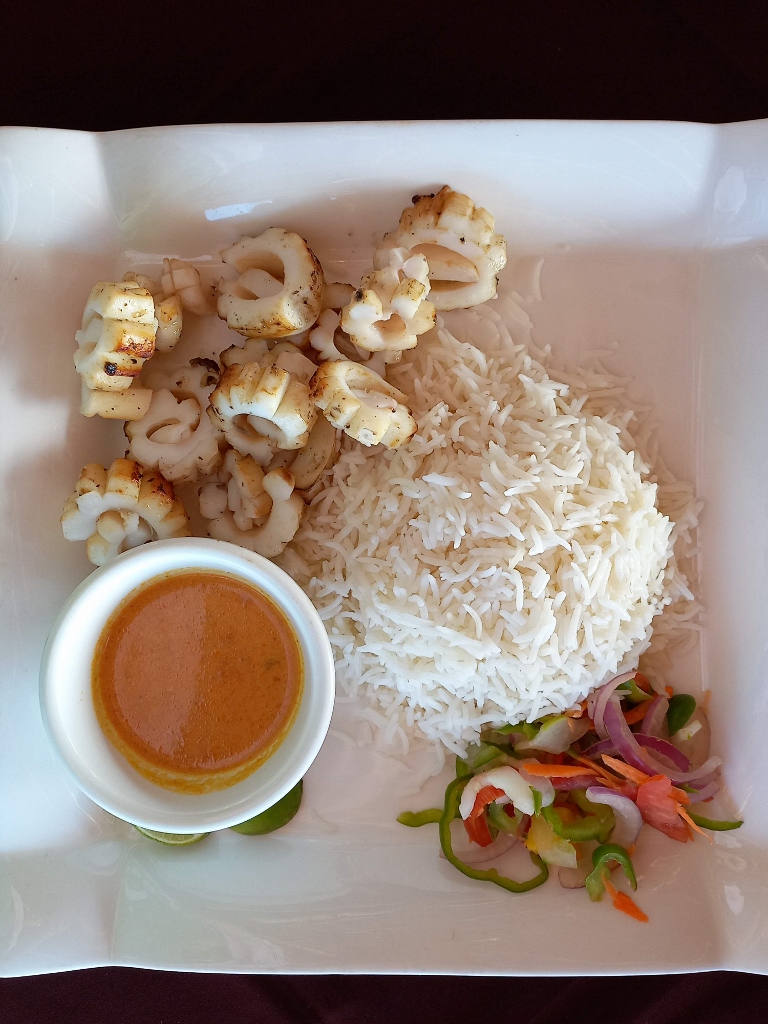 Light lunch in Zanzibar
Light lunch in Zanzibar
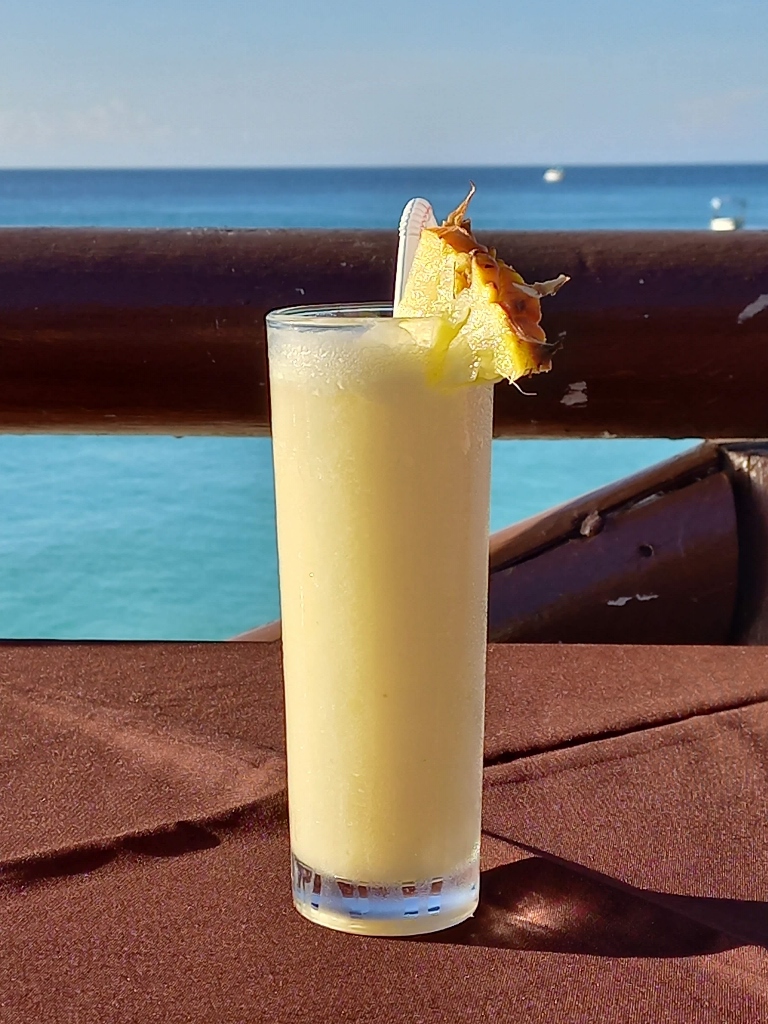 Refreshing drink in Zanzibar
Refreshing drink in Zanzibar
Later in the afternoon, the tide came up again, so it was nicer for swimming and until the evening I spent my time between the beach, swimming and the hotel terrace, enjoying the view of the same beach.
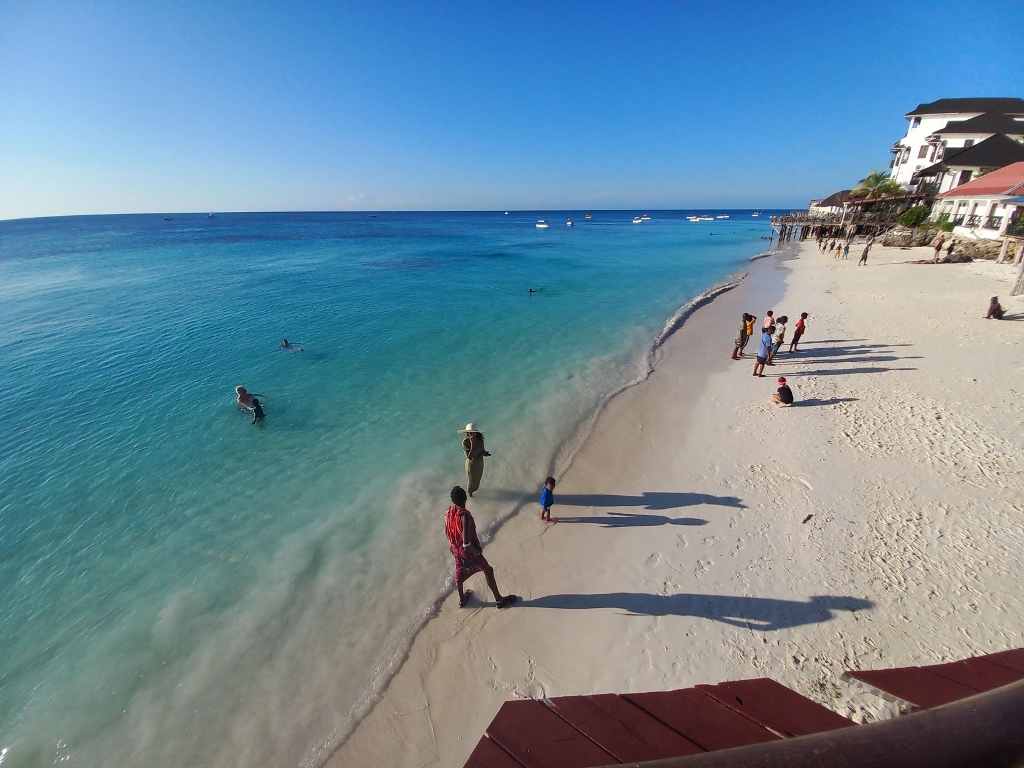 Nungwi beach
Nungwi beach
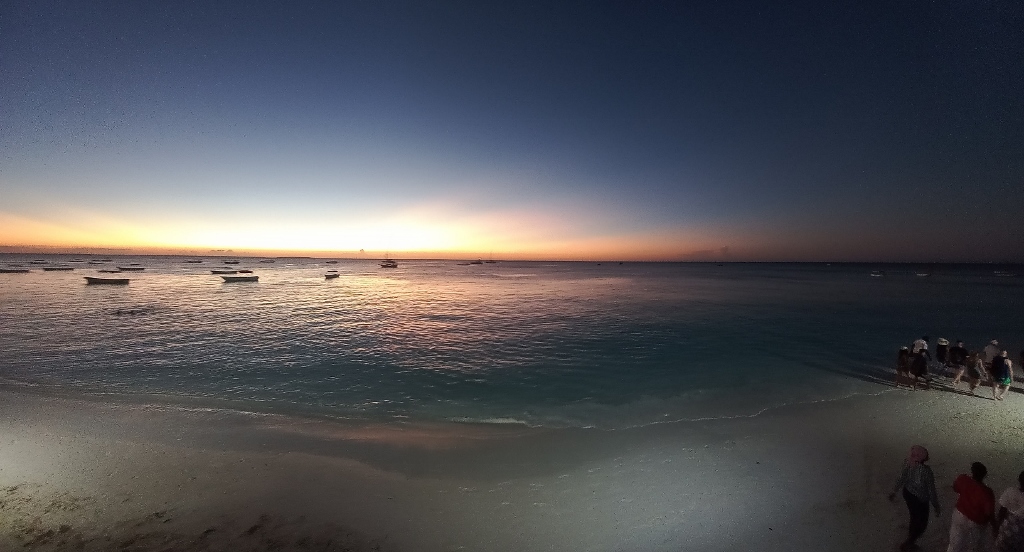 Nungwi beach
Nungwi beach
I spent the next couple of days very quietly. That was all the time I had left before returning home, so I was happy to keep my activities to a minimum.
Right after breakfast, I would first run into the water. A little in order to do some swimming before the low tide and also in order to take some photos. Both of these things were wonderful.
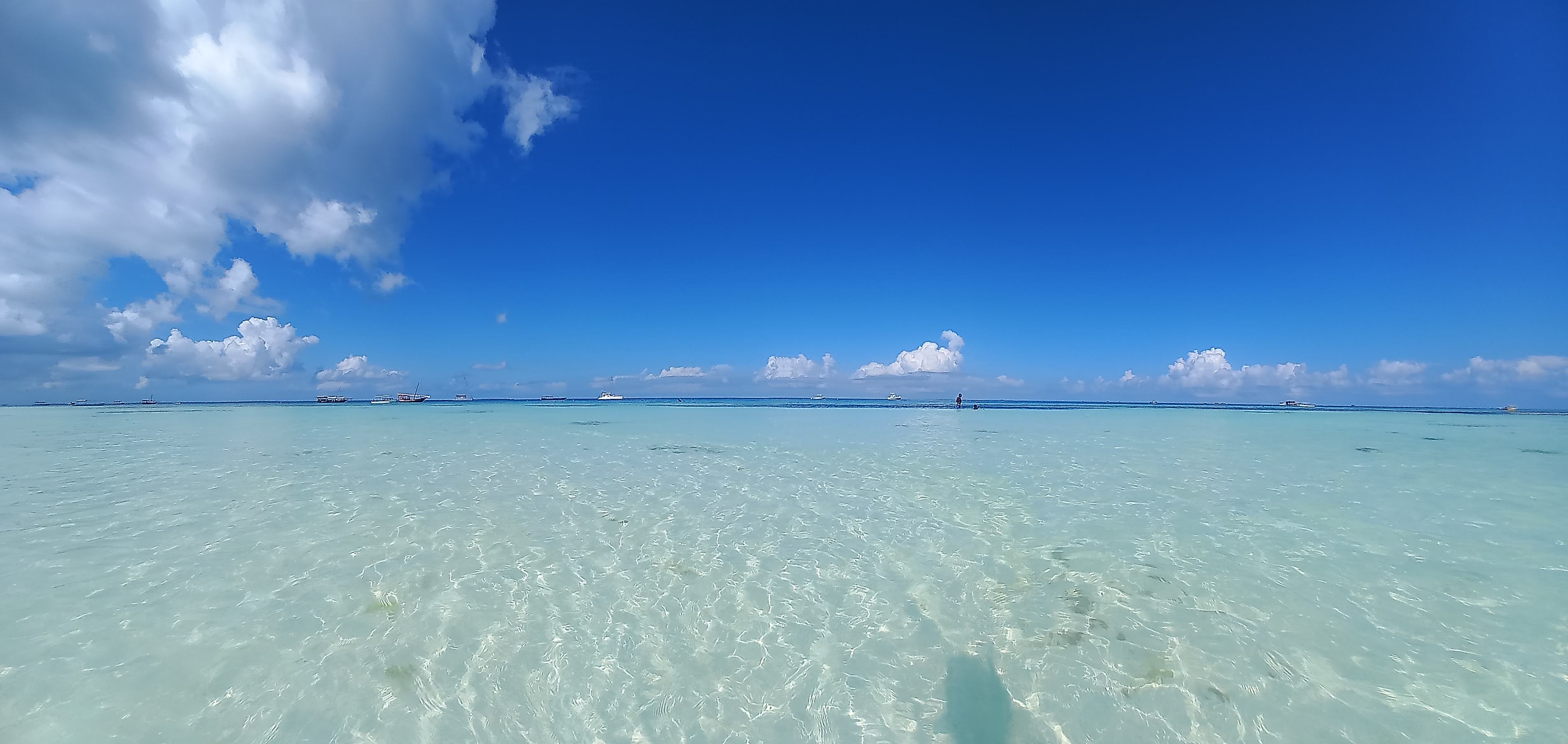 Nungwi beach
Nungwi beach
Then I would return to the terrace where I continued to have my coffee, but also in order to observe the events around me, including the reappearance of the local women who were collecting something in the now shallow water. This should not be interpreted as an exploitation of women, since the very next photo shows a fishing boat in the background with men on it. It is clear that they were returning from fishing in the open sea because a large flock of seagulls can be seen around the boat.
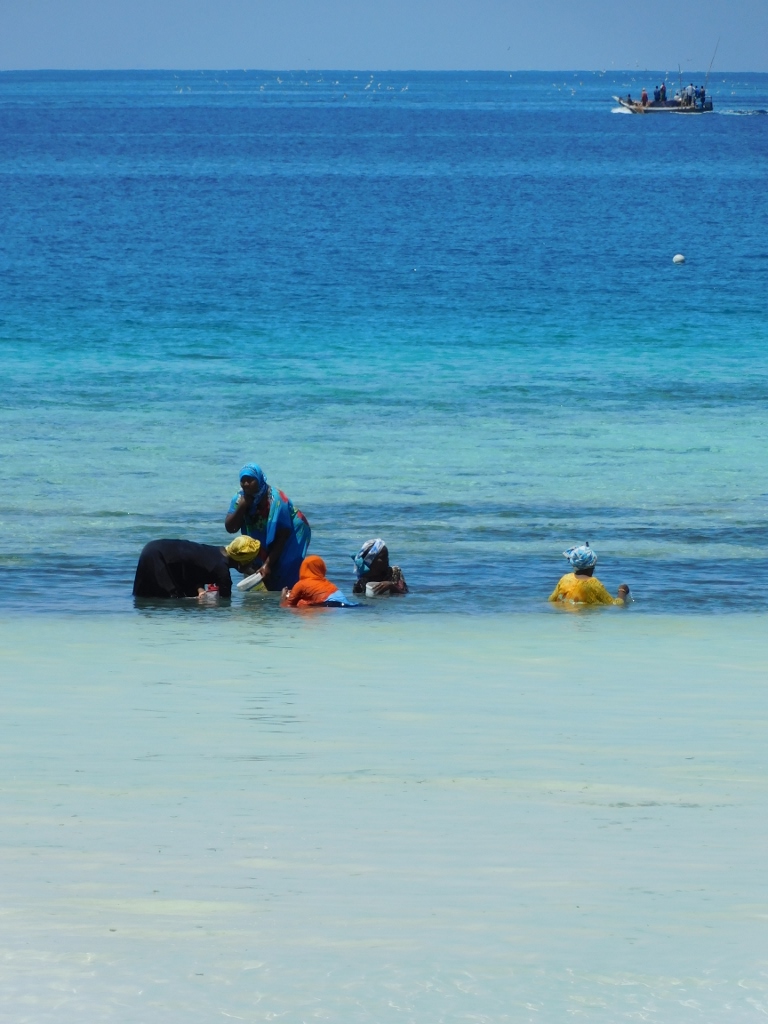 Nungwi beach
Nungwi beach
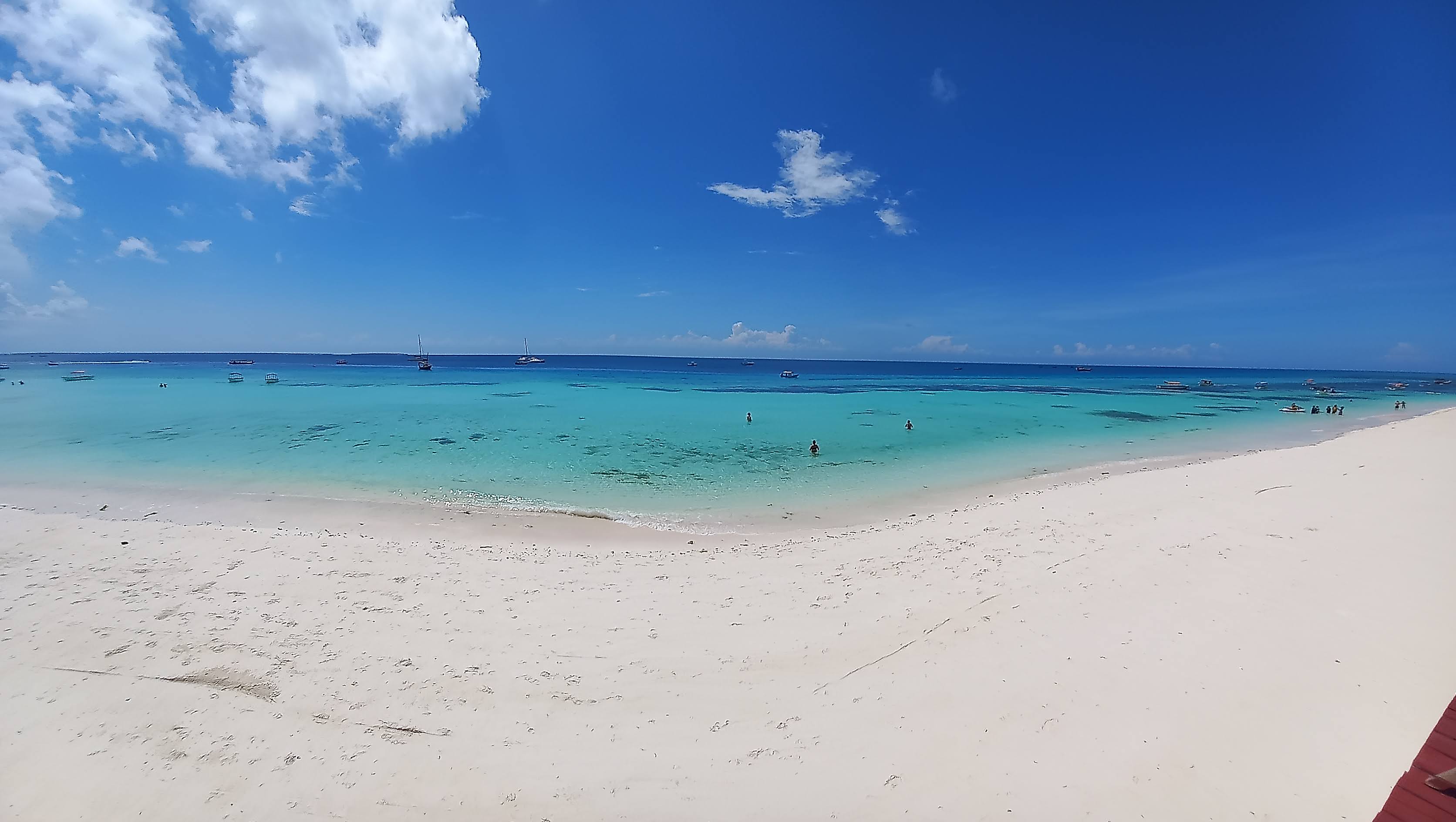 Nungwi beach
Nungwi beach
And yet, although over time I have learned to relax and not do anything for a long time, I also really like to move. That’s why at some point I went for a walk around the hotel, which is very touristy.
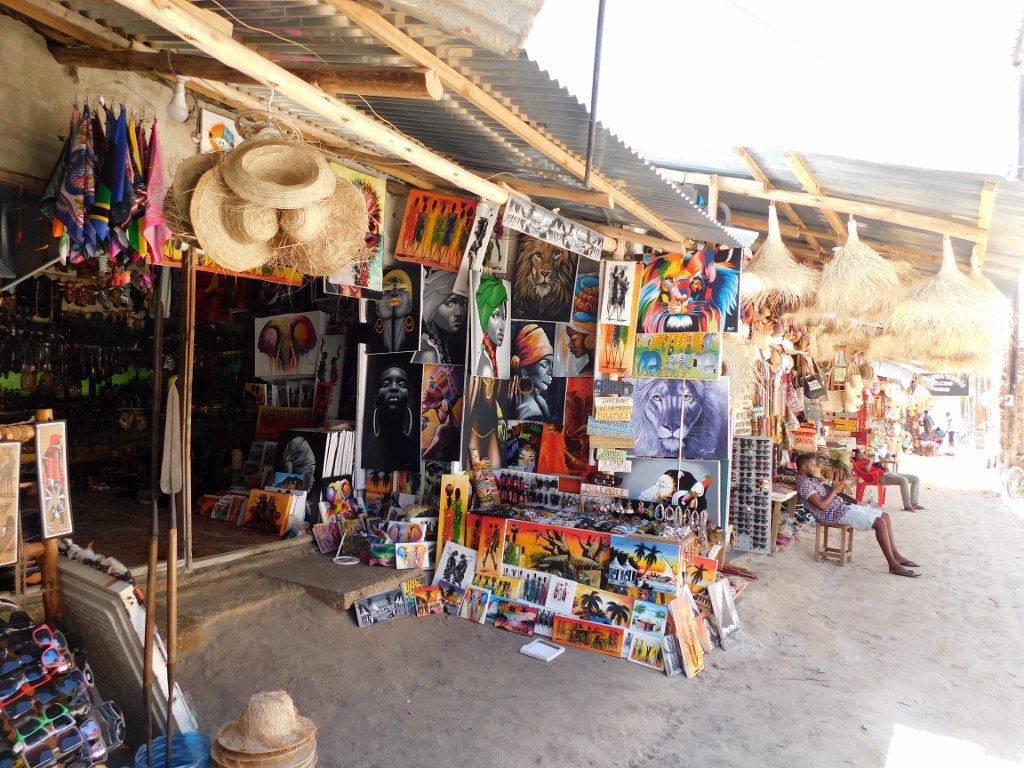 Tourist part of Nungwi village
Tourist part of Nungwi village
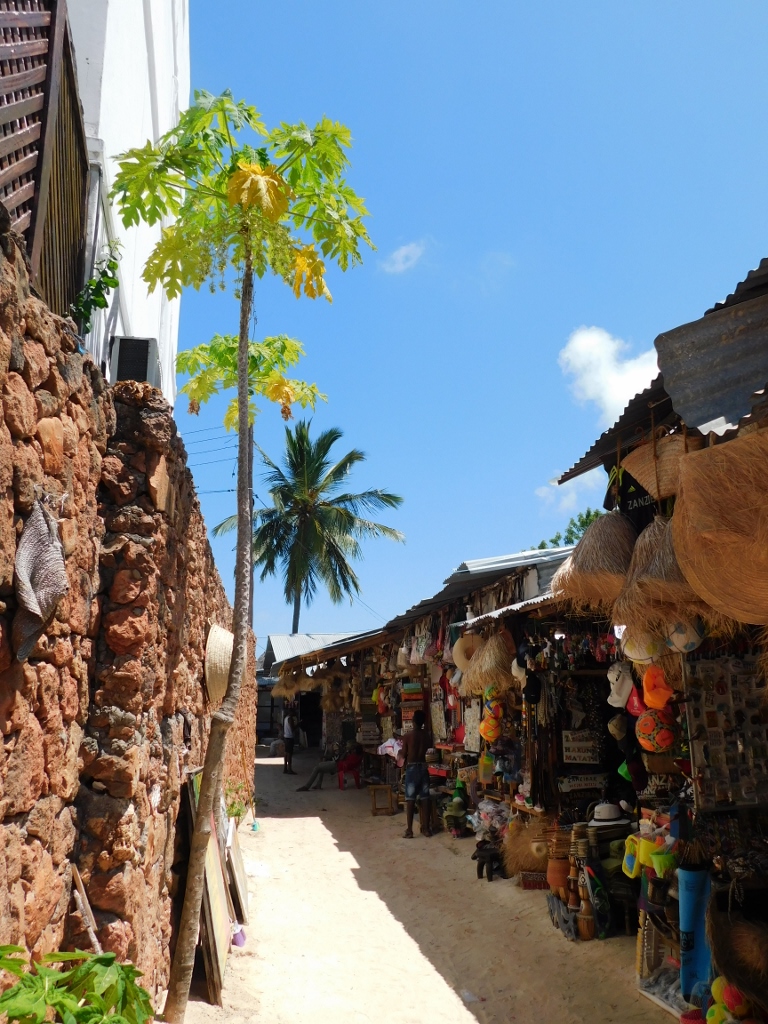 Tourist part of Nungwi village
Tourist part of Nungwi village
Along the way, in several places I could admire the flame trees (Delonix regia) with beautiful and lush bright red flowers.
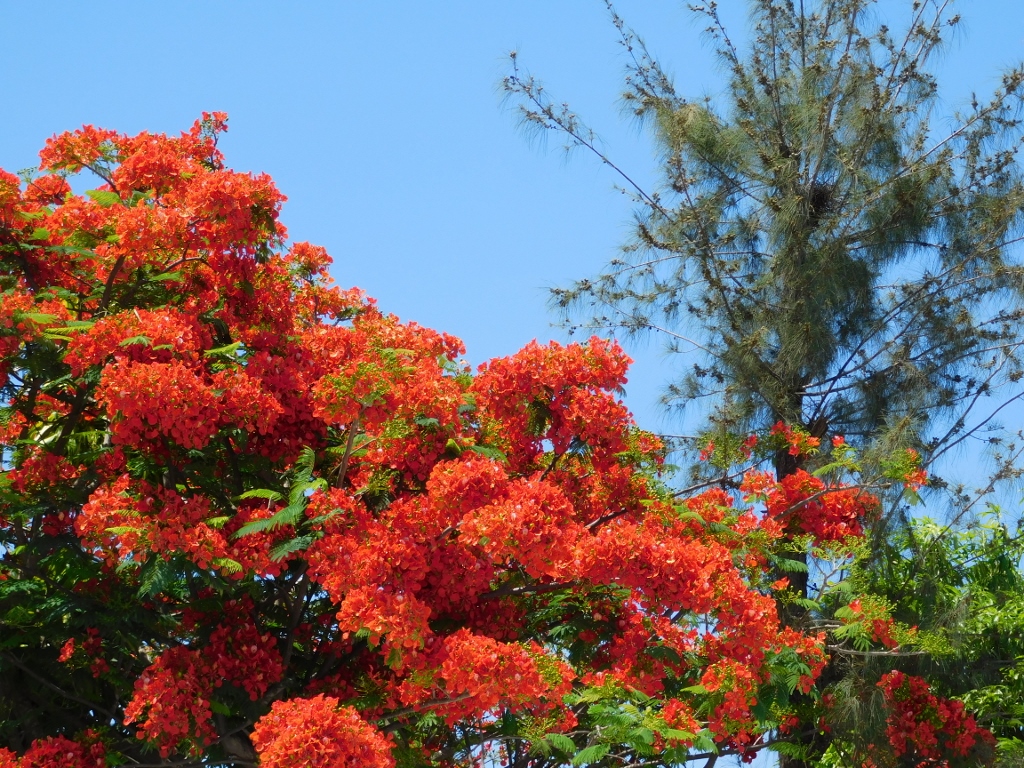 Top of a flame tree
Top of a flame tree
Then I went back to the hotel again where I admired the beach (again). The beach looked absolutely fantastic in the early afternoon, as the colours came to the fore especially at that time of the day. The photos reflect this up to a point, but the video is even better.
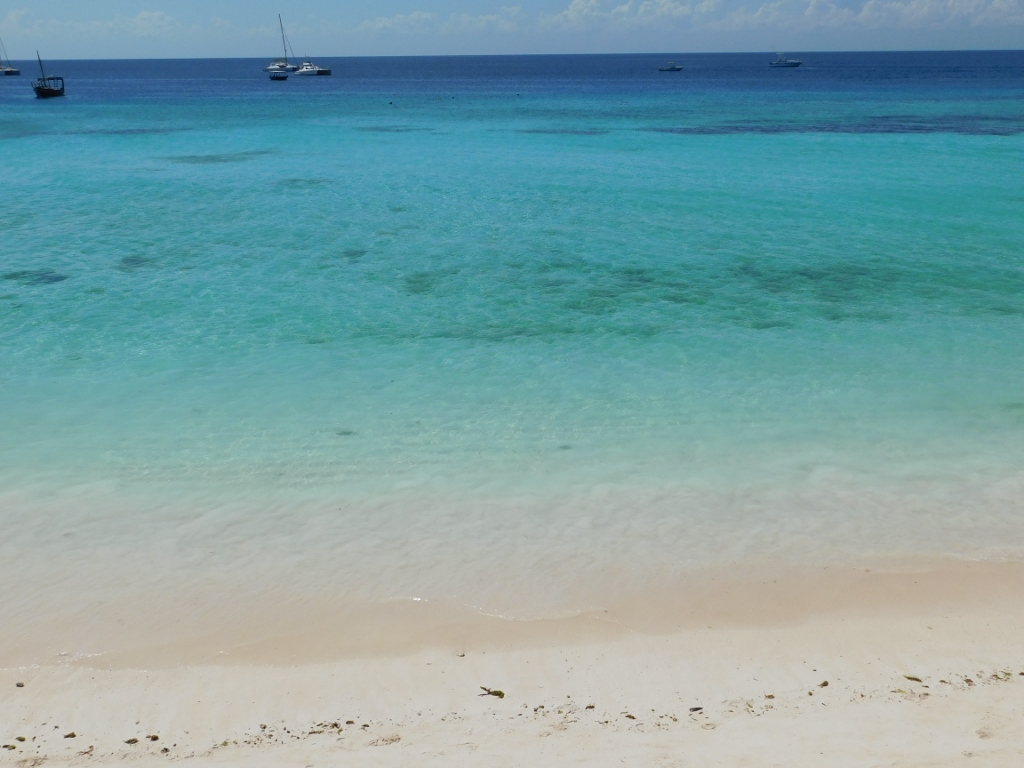 Nungwi beach
Nungwi beach
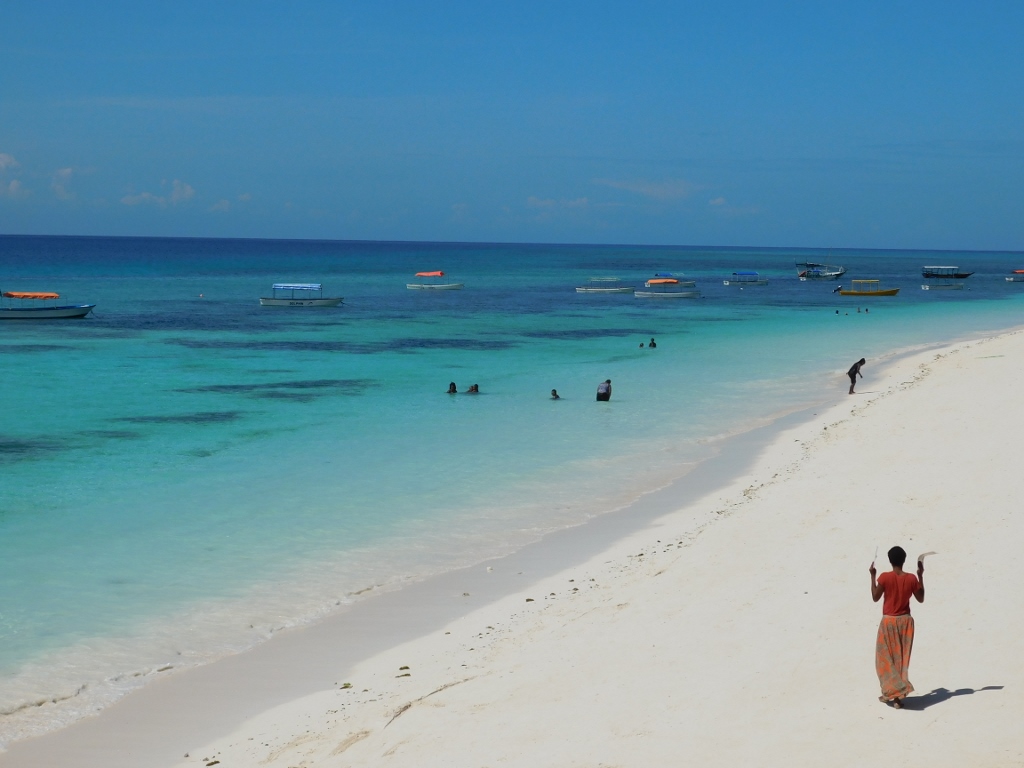 Nungwi beach
Nungwi beach
A little later I realised that I should also have lunch, but now I decided to walk to the extreme northern part of the island, which is still part of Nungwi village, where there is also a beach. On the one hand, I wanted to see that part of the village, but I also wanted to change the place where I had lunch.
Nungwi extends both along the west side of the tip of the island (where the hotel I was staying at was), but also along the north and the east sides. It would certainly have been good and interesting if I had walked to the east coast as well, but I have to admit that on the one hand it was very hot and on the other hand I was partly lazy, so I was very content with what I did in the end.
I walked a little along the wider streets of the village, which are all dirt roads, but I reached the beach through a narrow alley where I passed by an area where local fishermen mend their nets.
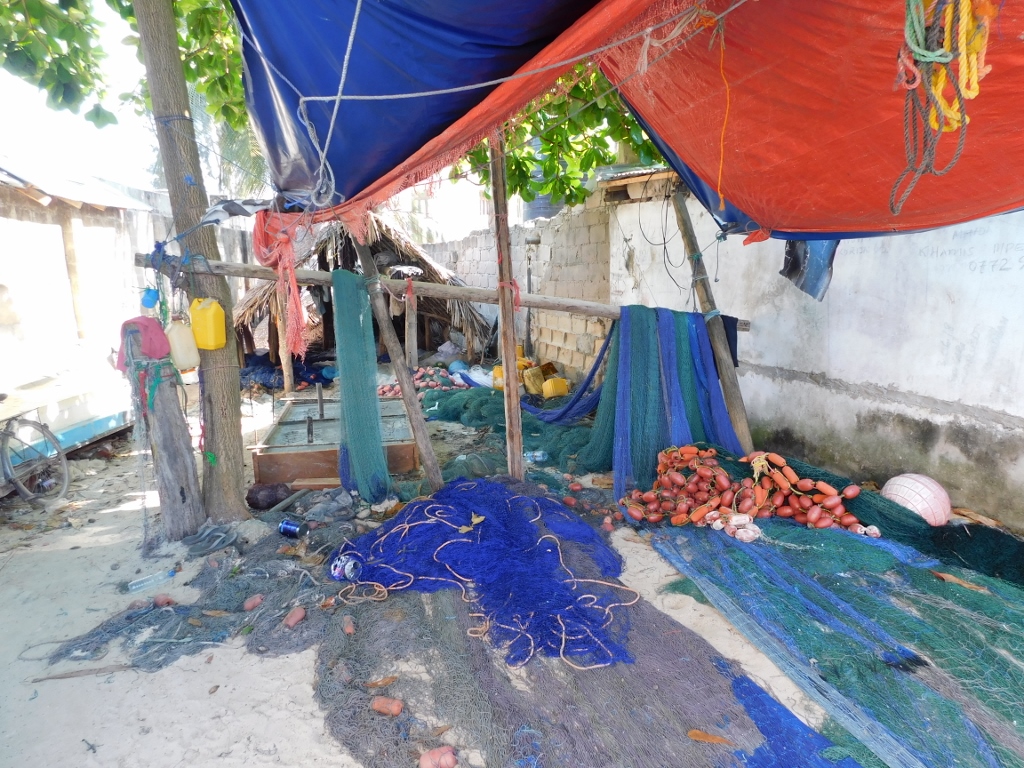 Nungwi village, a detail
Nungwi village, a detail
Lunch was not bad and I had a good meal because I had both an appetiser and a main course, all accompanied by freshly squeezed pineapple juice. I enjoyed the goodness of the juice made from fruit that grew and naturally ripened perhaps only a few kilometres away.
 Part of the lunch
Part of the lunch
By the time I finished eating, the sun was already starting to descend slowly towards the horizon and it wasn’t as hot as when I first arrived, so it was easier for me to stop and take photos of different parts of the village.
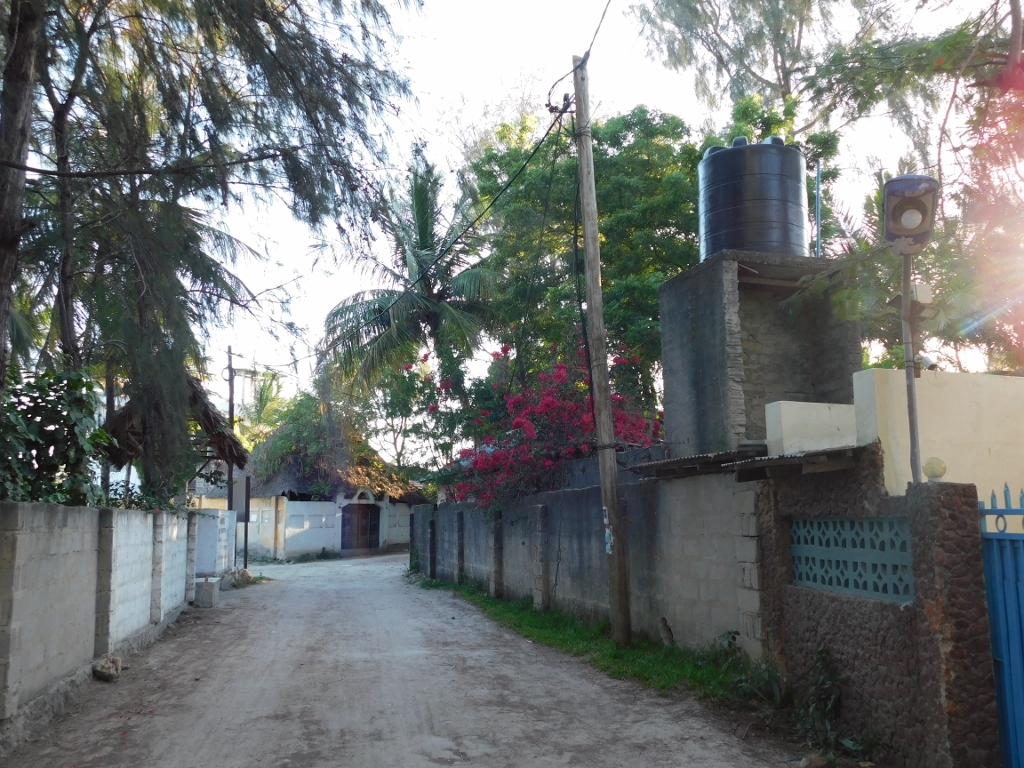 Nungwi village, a detail
Nungwi village, a detail
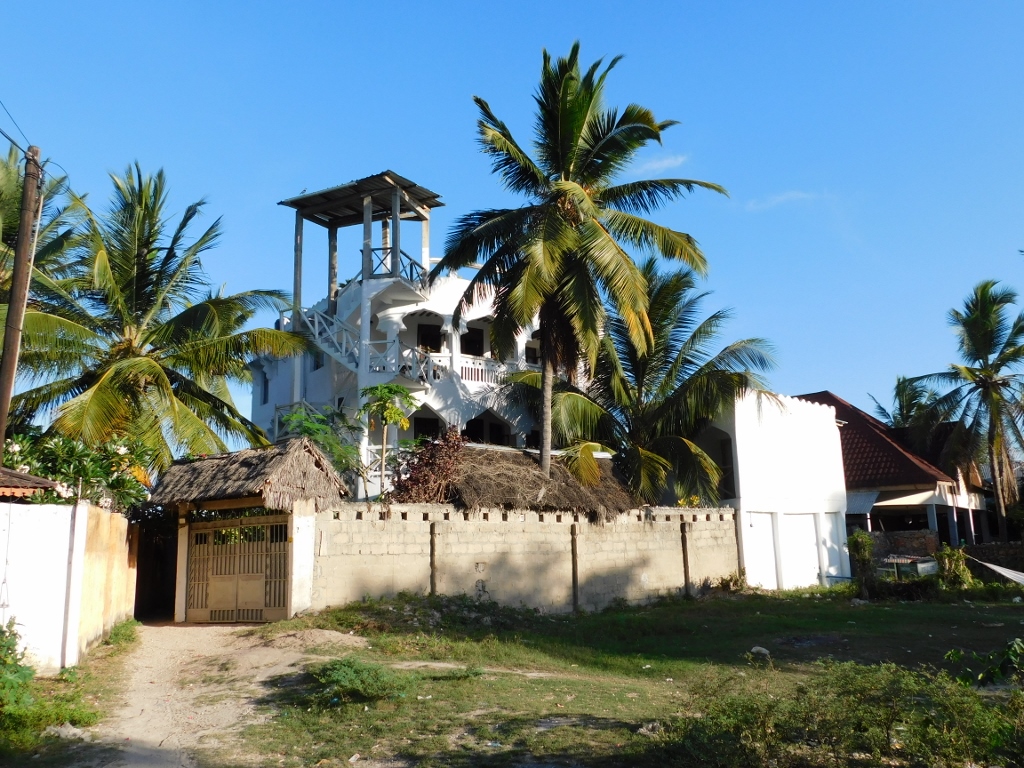 Nungwi village, a detail
Nungwi village, a detail
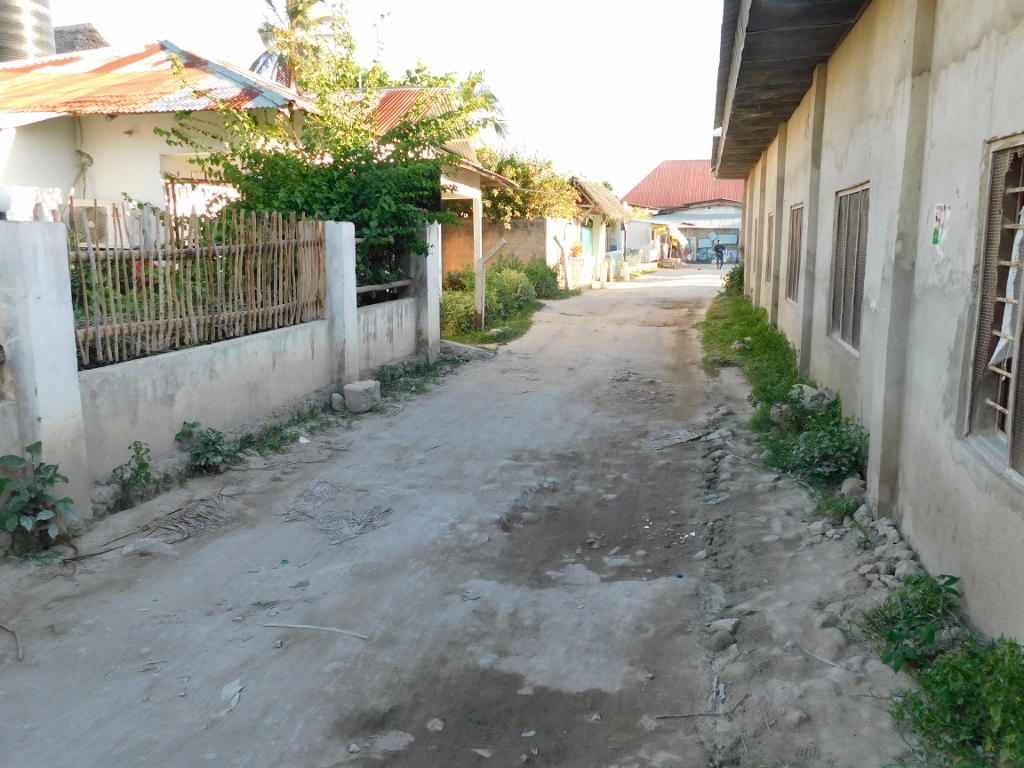 Nungwi village, a detail
Nungwi village, a detail
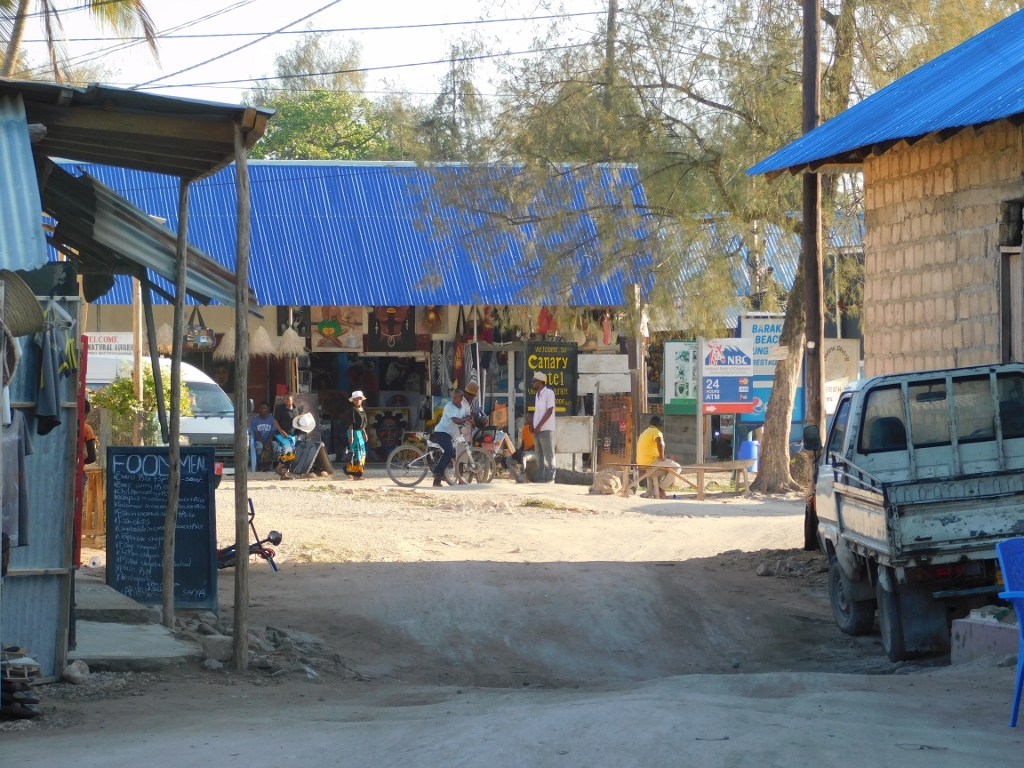 Nungwi village, a detail
Nungwi village, a detail
On the last day of my stay in Zanzibar, I literally did not leave the hotel or the beach. Admittedly, I didn’t even feel the need because everything I saw there seemed perfect.
There were still some Maasai people walking on the beach in their traditional bright red clothes and after some time the water ebbed away, so again some children were frolicking in the shallows, while the women were mostly hard at work collecting, I guess, seafood or perhaps they were just using it as an excuse to cool off.
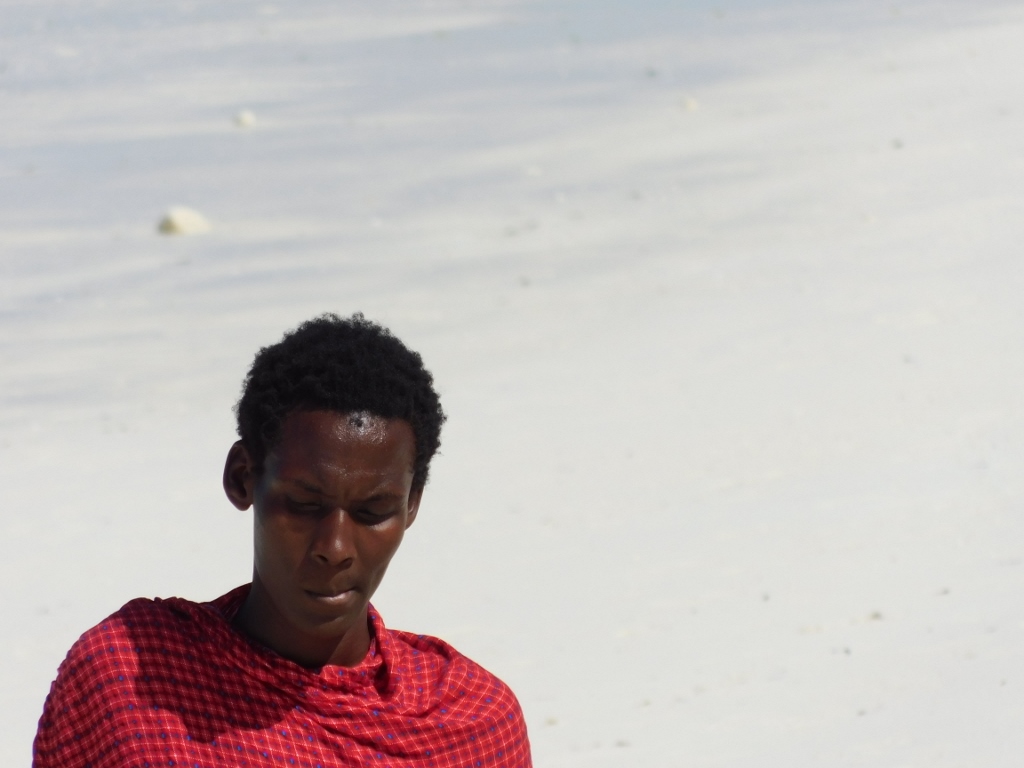 Nungwi beach, a detail
Nungwi beach, a detail
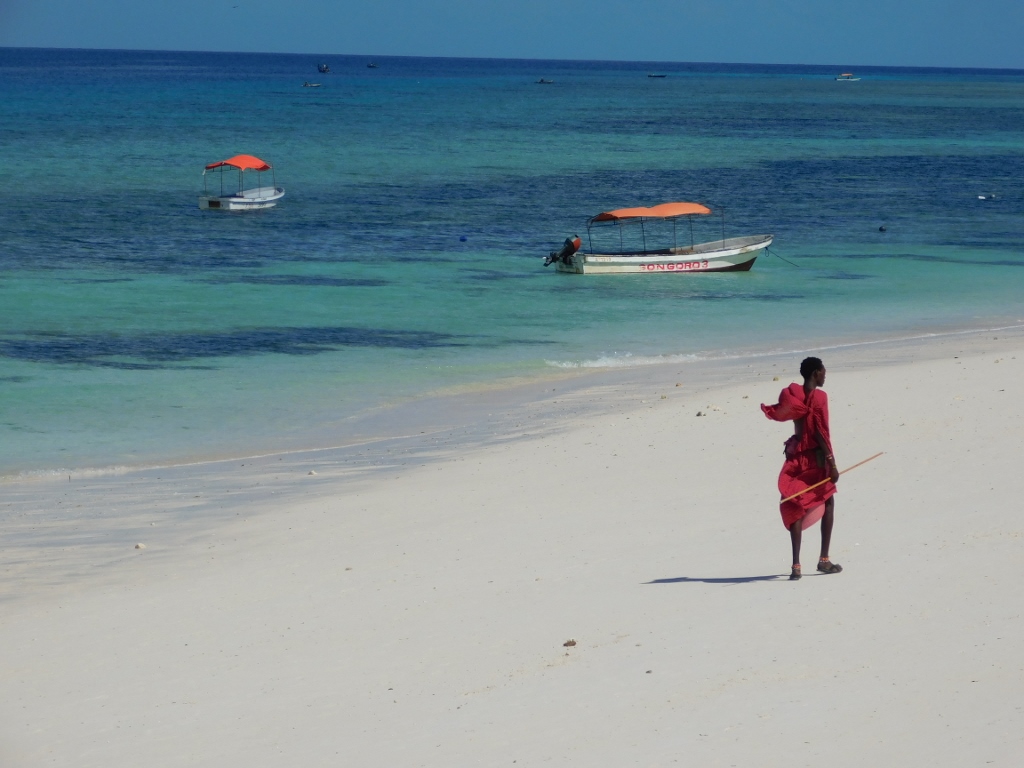 Nungwi beach, a detail
Nungwi beach, a detail
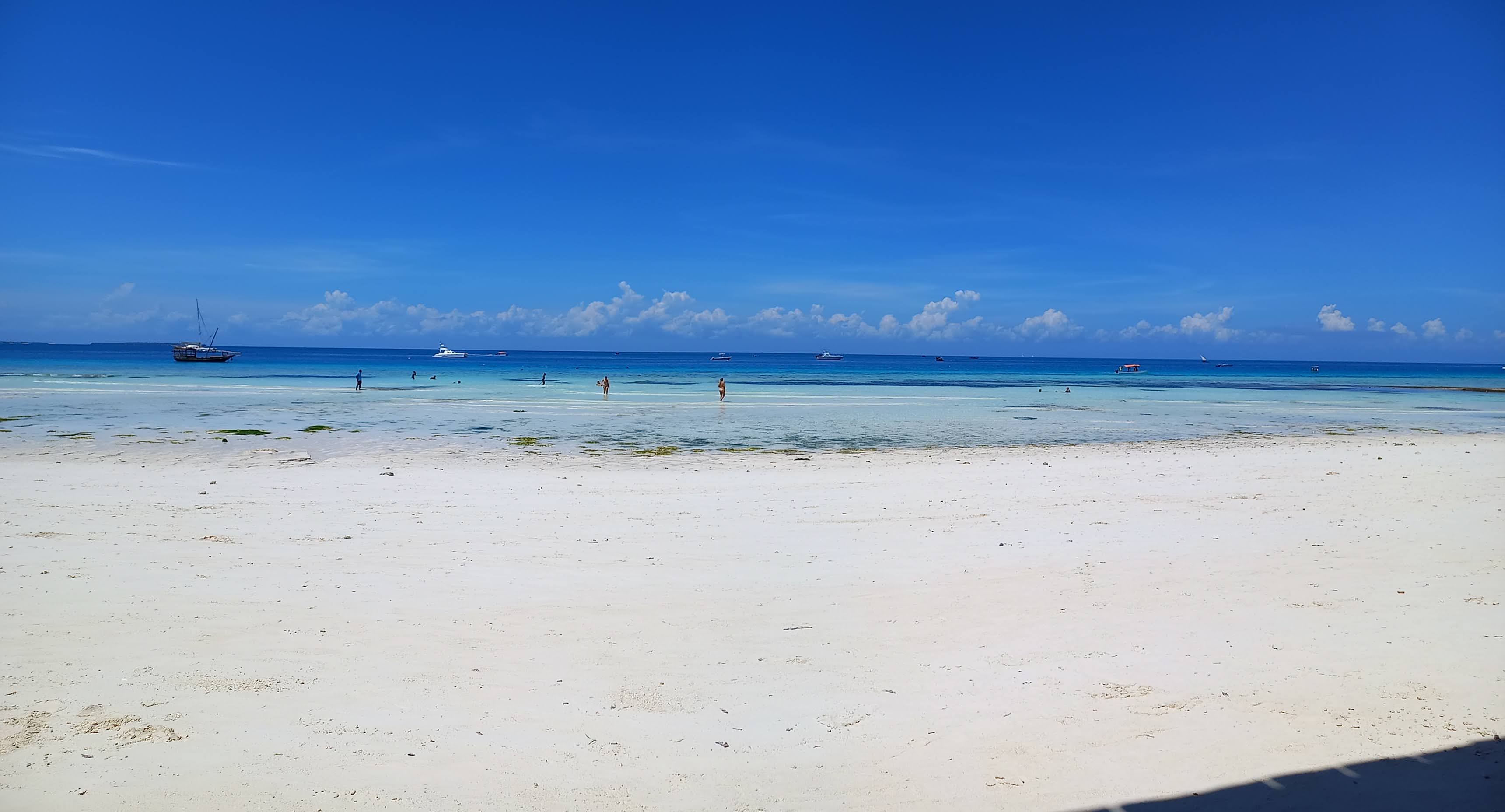 Nungwi beach during low tide
Nungwi beach during low tide
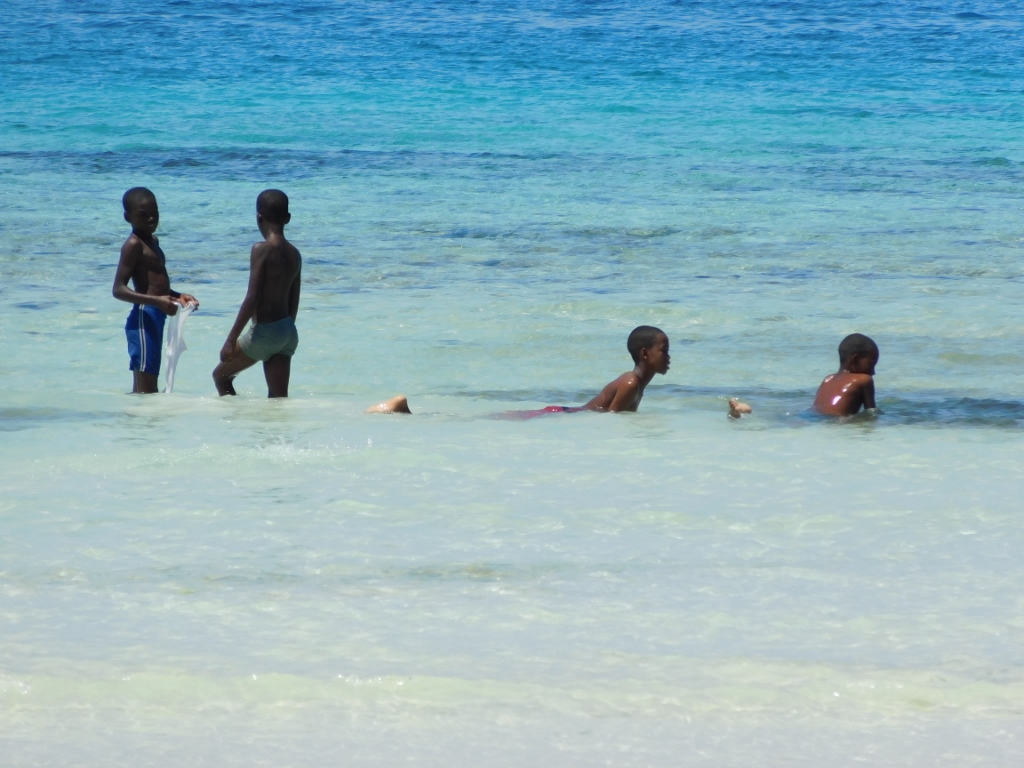 Nungwi beach, a detail
Nungwi beach, a detail
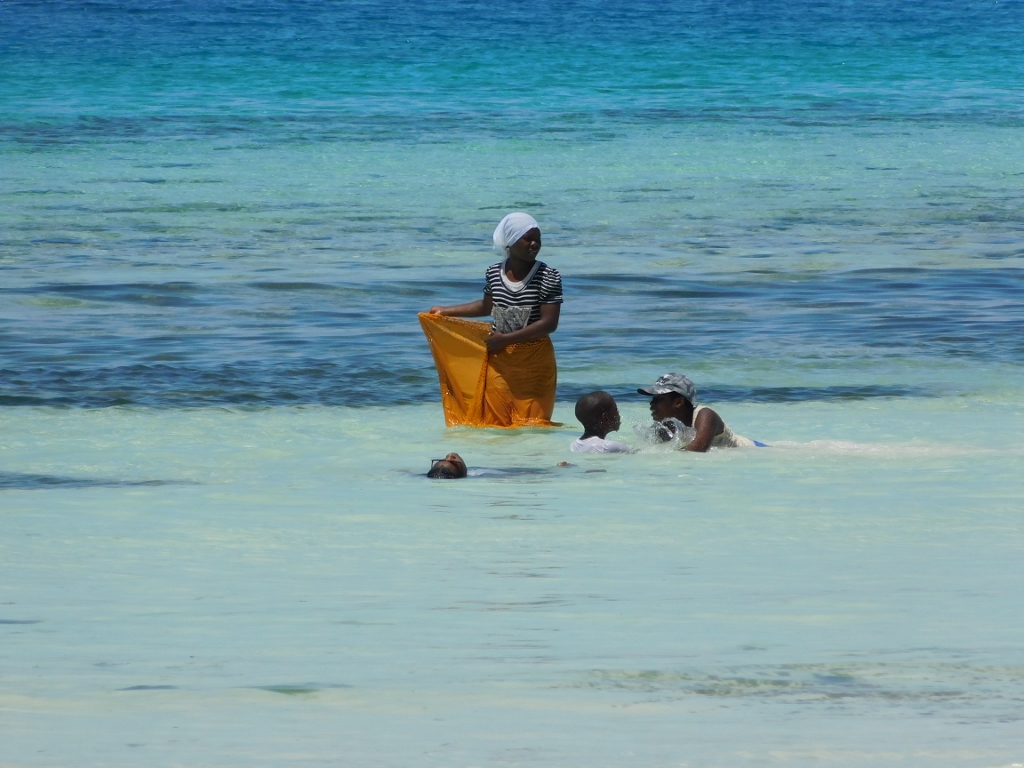 Nungwi beach, a detail
Nungwi beach, a detail
I spent a good part of the day in the company of a few of people from the group, including a wonderful, young couple from Niš, with whom I also went for lunch. It was all relaxed and fun, and we all tried to soak up a little more of the wonderful Zanzibar atmosphere and enjoy the beautiful beach and perfect temperature.
But, the time was passing and at some point the sun went down.
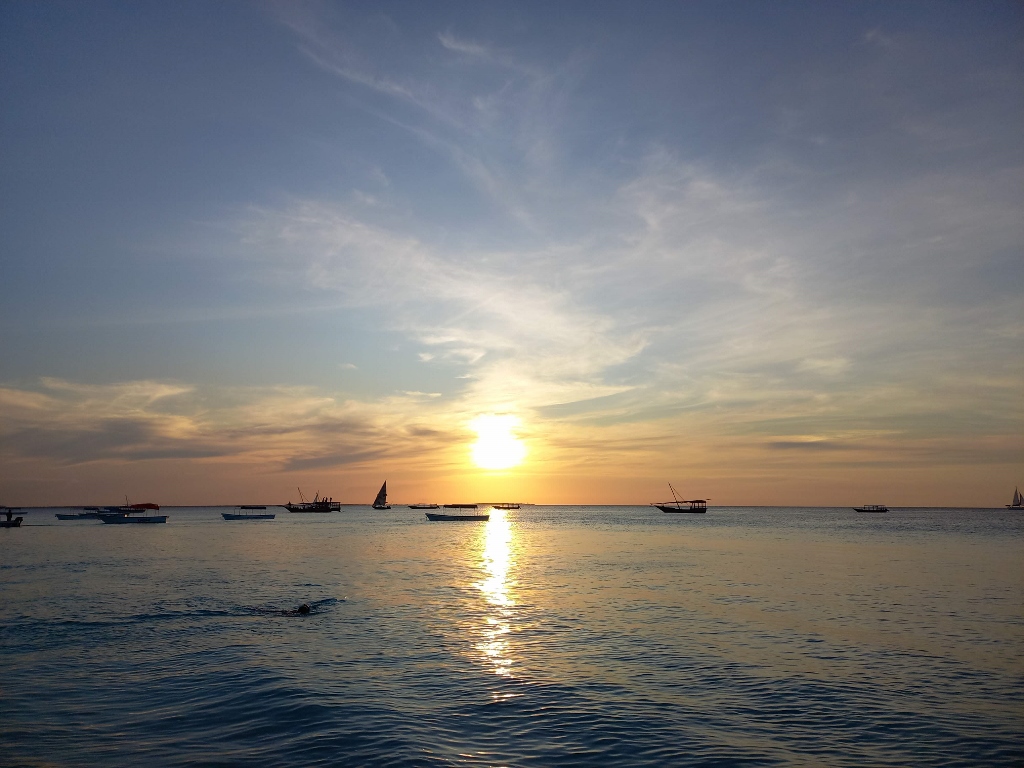 Sunset at Nungwi beach
Sunset at Nungwi beach
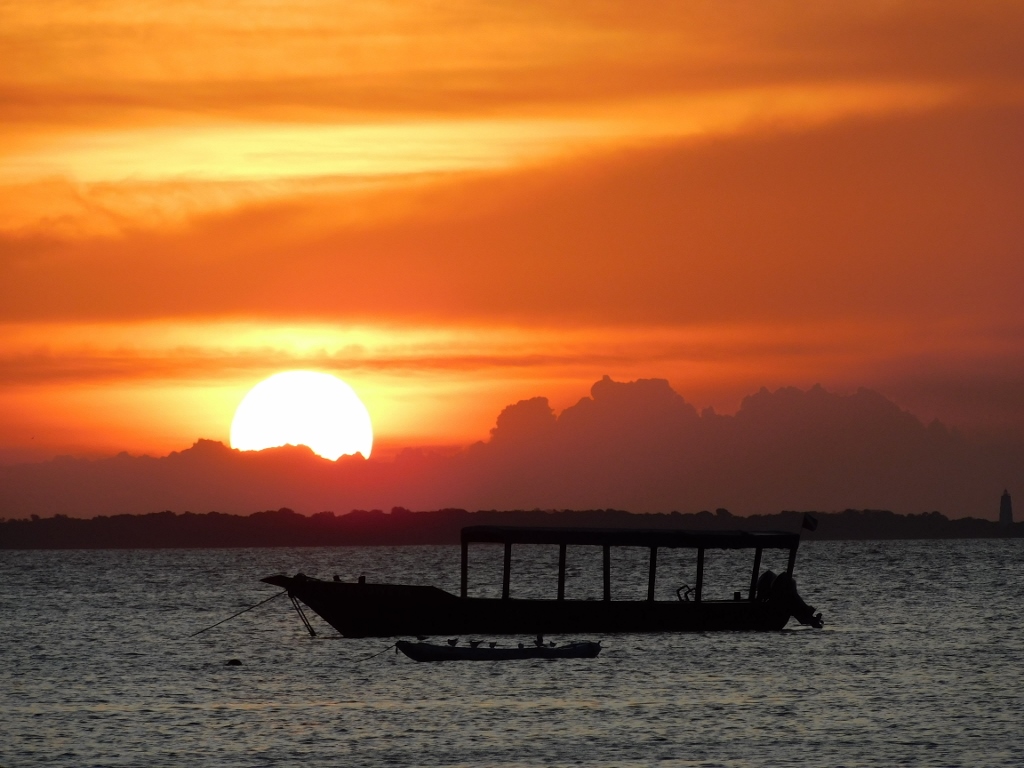 Sunset at Nungwi beach
Sunset at Nungwi beach
In the evening, I went for a drink with Lela, the woman I shared the room with and with whom I hanged around along the way. Later I just had to pack because there was an evening transfer to the airport and the return flights to Belgrade ahead of me. The summer vacation in the middle of winter had come to an end.